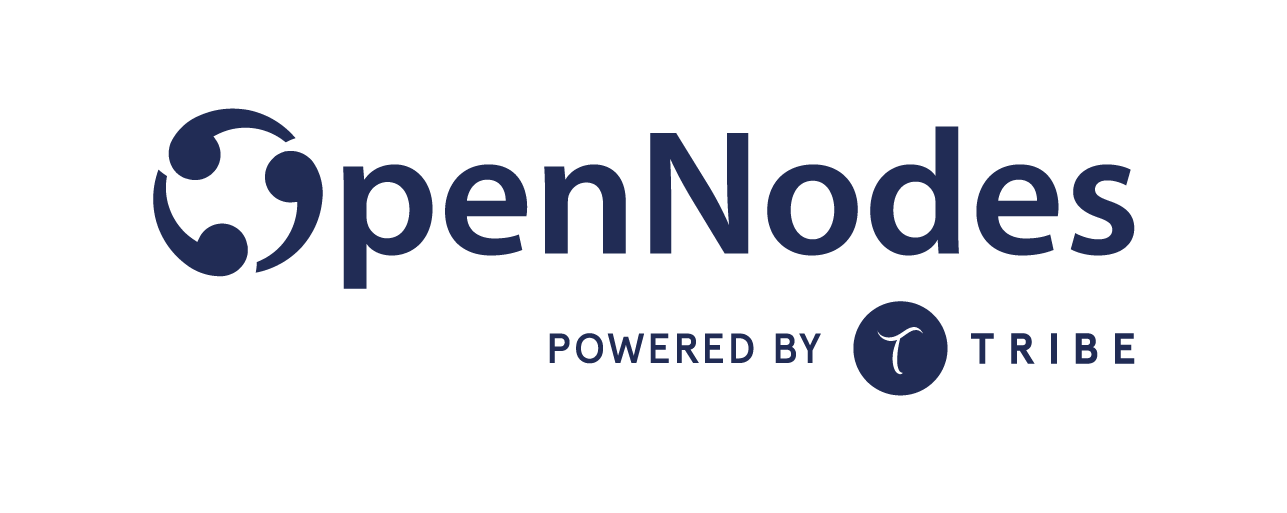
As part of OpenNodes' Campus Collective's effort to build up a vibrant tech ecosystem, we have prepared self-paced education content so that you can learn about blockchain in a guided manner.
The content in this course and roadmaps are made by students for students and would not have been possible if not for these contributors:
- Adithya Narayan (NUS)
- Alicia Loke (NUS)
- Bernard Choo (NTU)
- Eddrick Tay (SMU)
- Jo-Adam Mizra (SMU)
- Nicholas Hong (SMU)
- Simon Teo (NUS)
- Shi Ying Tey (SUTD)
- Shyam Sridhar (SUTD)
The syllabus of the course is designed to guide you from an absolute beginner in blockchain technology to be able to work with smart contracts.
When you complete this course, there is an avenue for you to apply your knowledge with OpenNodes Campus Collective. This will grant you more opportunities to scope and create your own activities together with the Campus Leads. To do this, there is a test you have to complete. Try your hand at the challenge here.
Phase 0: The content is designed for people who have never heard about blockchain. When you are done with this phase, you should be conversant in blockchain content. This means you should be able to read and discuss blockchain content you find off the net.
Phase 1: Armed with some knowledge of blockchain, this segment will help you identify the suitability of use cases in blockchain and give you an idea of what the ecosystem is like.
Phase 2: Non-technical folks may try the challenge after completing this phase. It will teach you how to interact with the test net. You will learn how to come up with your own use cases for blockchain technology.
Phase 3: For the technical folks, this phase will teach you how to work with smart contracts. There will be just enough solidity taught for you to follow. The content is made so that you will learn major classes of smart contracts simplified for you to understand the logic. Thereafter, you may try your hand at the challenge.
Visual Grammar of this course
This course is put together with Google's Codelab tools for authoring and serving codelabs.
In addition to this self-paced content, we have also put together roadmaps for you too.
Blockchain Roadmap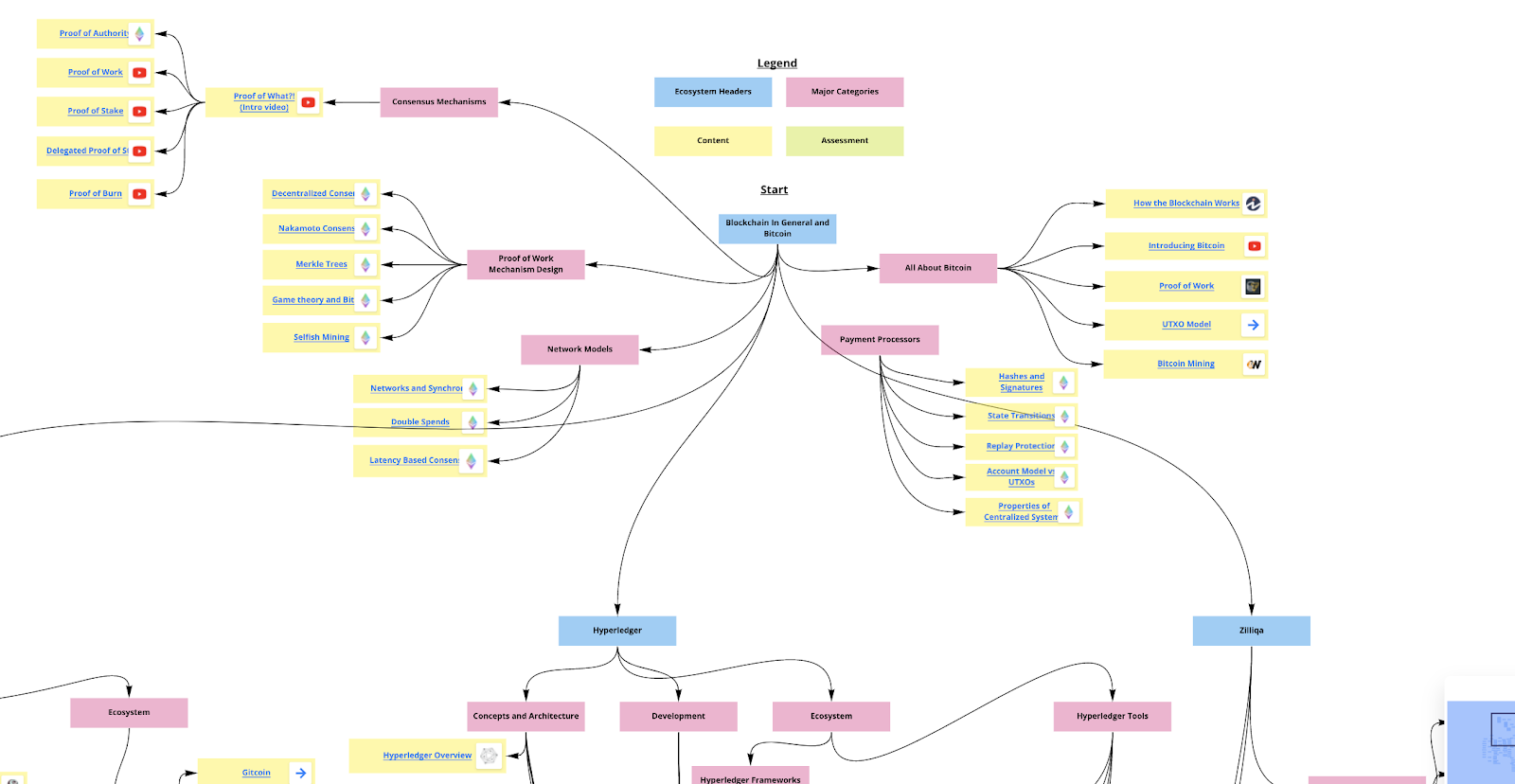
For an overview of a typical blockchain skills journey, this roadmap is for you.
The basic idea of having the roadmap in place is so that you could get an idea on where you currently stand in your journey of self-discovery and chart out your course accordingly! How it works is that, you would first be expected to learn the fundamental concepts of Blockchain technology and Bitcoin. Once you have mastered this, you could go on to deep dive into Blockchain Development by learning the tools necessary to build apps on Ethereum, Hyperledger and Ziliqa! Just follow the path that eventually terminates to a terminal-node where you will be provided with the links to read more about the specific topic at hand.
Digital Consulting Roadmap

If you're non-technical and would like to have an idea of how technology consulting works, this roadmap is for you.
Check out what a typical process is like and chart out the key activities a consultant might do in a project. There are also useful resources for you to peruse if you'd like to pick up these skills.
What
All power is distributed and dispersed away from a central authority. Most financial and government systems currently in existence are centralized, which means that in such systems there exists a central authority that is incharge of maintaining and managing them.
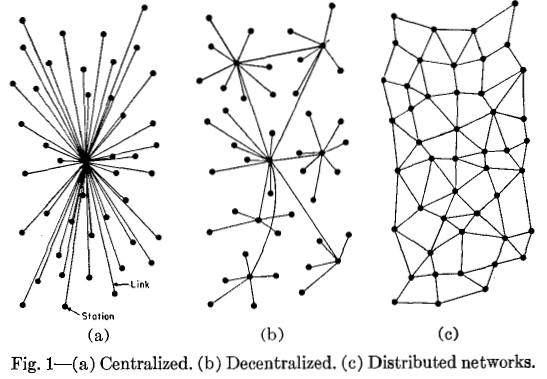
There are several forms of decentralisation with varying degrees for each form leading to different properties and tradeoffs.
You can be decentralised in terms of architecture, culture, control, and decision-making.
- Architecture sets forth the different roles of network participants and how they interact. A highly decentralised architecture will ensure that all peers have the exact same role and thus exert the same level of influence. A centralised architecture would give a single peer near full control of the network while other participants may only interact with it in limited ways. This can also affect the consensus protocols peers use.
- Culture defines the social norms of the people that interact with the network. This could be in terms of the developers that build the software of the network, developers that build applications on the network, researchers that explore the potential and pitfalls of the network, and anyone that essentially has a stake in it.
- Control of the network can be done in several ways but ultimately resulting in the governing of the network's participants. This may involve legal structures as to how the network is funded or the amount of changes each peer can make on the network itself.
- Decision-making processes determine the growth of each network and help in the weighing of trade-offs that might have to be taken. As the technology is new, there are challenges that are unsolved and unforeseen. Having a robust decision-making process is important to ensure that the network can evolve to adapt to each challenge, social or technical.
This concept is fundamental to blockchain technology as it is its key value proposition for most use cases.
Decentralization can be viewed from a blockchain perspective as a mechanism that provides a way to remodel existing applications and paradigms or build new applications in order to give full control to users. There are conflicting ideas on the importance of decentralisation but most agree that it removes the need for trust when parties collaborate. This gives rise to new types of goods and services that are still untested.
Issues
Scaling – there are challenges in keeping a network decentralized if one intends to scale. A common problem is the transaction speed, which plagued Ethereum for quite a while. Some solutions involve lowering levels of decentralization as a tradeoff for faster transactions, but it fundamentally lowers the level of security of the network due to the need for trusted parties (eg. Supernodes)
Economics – as a network grows, one cannot predict how its peers might interact when utilising the resources a network provides. This might lead to levels of centralization in a network. (Mining power centralization, Centralised exchanges)
Why
- It allows for greater participation between non-trust parties
- Better reliability in your network as you do not rely on central intermediaries (uptime, processes etc)
How
Using the forms of decentralisation as a guide:
- Architecture
Bitcoin - Full nodes, Light Nodes.
Full Nodes | Light Nodes |
|
|
Hyperledger Fabric - Client, Peer, Orderer
Client | Peer | Orderer |
Submits an actual transaction-invocation to the endorsers, and broadcasts transactions-proposals to the orderer | A node that commits transactions and maintains the state and copy of the ledger. Can also have a special endorser role | Node running the communication service that implements a delivery guarantee |
- Culture
Open source - an ethos that values collaborating on community projects
Linux Foundation - arguably the most successful open source foundation. Their involvement in blockchain is through the Hyperledger project.
- Control
Ethereum Foundation - incorporated as a Swiss non-profit at Zug, Switzerland. Provides Ethereum Grants that pay for teams that work on projects.
- Decision-making
Ethereum Improvement Proposals (EIPs) - are standards specifying potential new features or processes for Ethereum. EIPs contain technical specifications for the proposed changes and act as the "source of truth" for the community. Network upgrades and application standards for Ethereum are discussed and developed through the EIP process. This is currently how all decisions are made.
Which
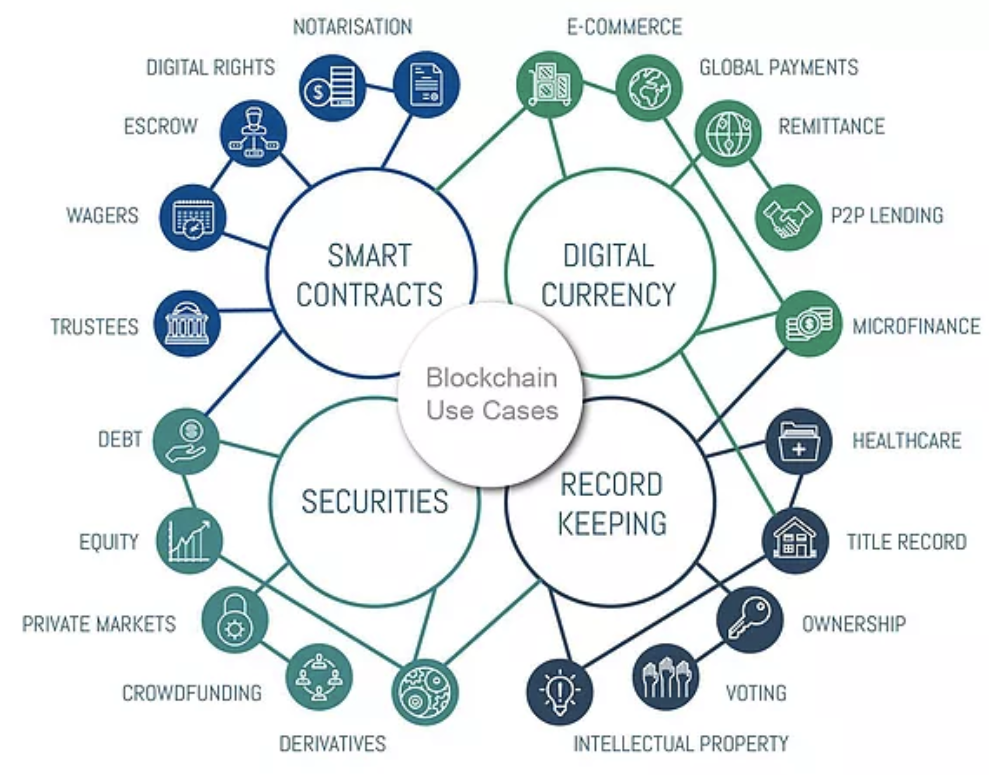
Self-sovereign identity where users can manage your own reputation, data, and digital assets
ID2020 - supports digital identity programs across the world
uPort - build tools for decentralised identity data management
Decentralised exchanges that requires no central coordinating party and all participants interact based on incentives
Kyber Network
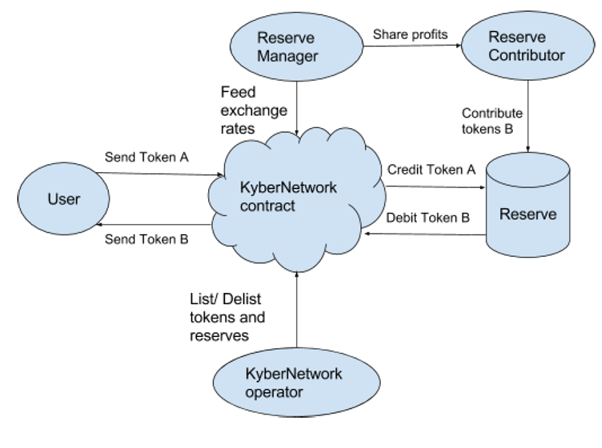
Decentralised Autonomous Organisations allow participants to carry out democratic processes without trusting any particular institution as a central party. This could be through decentralised means to propose ideas, vote on ideas, making decisions for the organisation or individuals all carried out through smart contracts.
MakerDAO - provides a stable digital currency. The DAO sets the ‘stability fee', ‘collateralization ratio' and triggers an ‘emergency shutdown' if needed.
What
All interaction is made reliable by making it unchangeable by any single party, ensuring that activity records and network participation rules are agreed and kept until all necessary parties agree to change them.
The structure of the blockchain itself affords the ability for individuals to independently verify the current state of the network. Each peer can compute the blockchain records for themselves to replicate the changes in the state of the network. A malicious peer will have to compute the consensus protocol for blocks already mined and then outcompete all the miners and broadcast their blocks first to every peer.
Consensus protocols cannot be easily changed and require a fork.
A fork can also be used to roll back records but it requires most peers to agree to the fork.
This makes digital goods act like real physical goods and not just a digital representation.
When records can no longer be easily changed by any single party, this creates a new type of good that is purely digital. This is because previously, people could simply make copies and replicate the good, thus no digital good is scarce. The immutability of the records achieved through decentralisation means that the state of such a good must be agreed upon by the entire network, analogous to physical goods that can be verified independently through sight or touch.
Issues
Hard forks - rewriting large portions of the blockchain means that records are not absolutely immutable
Irreversibility - wrong actions once accepted and confirmed by the network cannot be easily reversed. Data on the blockchain will stay on the blockchain. Vulnerable smart contracts can be easily decompiled and exploited. The infamous DAO attacker left his message to the Ethereum Community. See it for yourself in the blockchain explorer where multiple transactions were made resulting in a loss of $70M.
Why
- Sets forth a new paradigm by no longer requiring record-keeping intermediaries
- Overcomes the need for trust in records kept as you can verify independently
How
In Blockchain systems, the transactions that are verified are embedded with a time stamp that are secured through hashes. The hash of any new record links together and incorporates the hash of the previous record. Through this we get a chronological chain that joins each block.
Since the entire hashing process always includes the metadata of the previous block while generating a hash for any new block, an "unbreakable" link between the block and the chain is established. After this no further modifications [such as deletion and alteration] can be made to the block that has been included in the chain. If anyone does attempt this, subsequent blocks of the blockchain do not accept the modification as the hash of the block wouldn't be valid anymore.
In Summary:
New records - keep the hash of the previous block and a unique nonce, miners compete to find the nonce for the next block
Old records - easily verified that previous blocks are correct by hashing the blocks and checking that the nonces are correct
Which
ERC721 - To emulate rare, collectible items with Ethereum tokens by making these tokens non-fungible.
ERC20 - Allows smart contracts to act very similarly to a conventional cryptocurrency so that this, hosted on the Ethereum blockchain, can be sent, received, checked of its total supply and checked for the amount that is available on an individual address.
What
The ability to hide the link between transactions and addresses are important due to privacy concerns
You can match the transaction to the address on the blockchain itself quite easily. When you go to a block explorer and view any block, you will see every transaction in the block, the miner, and any part of the block structure.
The pseudonymity that comes with most blockchains is that the address is not traced to a physical identity.
Even though the blockchain is considered public and immutable, individual transactions can be anonymous.
It's this pseudonymity that made blockchain technology an ideal method for illegal activity in its earlier days such as through Silk Road.
However once an address is linked to an individual, this pseudonymity is immediately broken and can be easily traced.
Issues
The problems with being traceable is the lack of privacy. One key concern is the General Data Protection Regulation (GDPR) that would make it impossible to conduct business on the blockchain.
Time - privacy schemes take longer to compute and might severely impact usability of blockchain applications.
That being said, there are new encryption schemes such as homomorphic encryption that might help resolve this.
Why
If privacy is implemented
- Potentially better control over personal data
- Information that requires secrecy can be conducted over public blockchains
If records are meant to be traceable
- Makes for a great audit trail for provenance
- Allows for fine analysis of actions that occurred over time by any peer
- Promote transparency
How
Making transactions traceable
Naive - you can just put your name on the transaction itself and you can be immediately traced to it.
Data science - such as this work on analysing decentralised exchanges. Google has also made the Bitcoin and Ethereum blockchains available on BigQuery.
Making transactions untraceable
Zero Knowledge Proofs - let's you prove that you know some secret to another party without revealing the secret itself
Homomorphic encryption - introduced by Ronald L. Rivest and Len Alderman (the R and A of RSA). It allows one to perform computations on the data without ever decrypting it.
This is a BIG deal because it's a major stumbling block for practical blockchain applications.
Which
Making transactions traceable

From "When to chains combine; supply chain meets blockchain" by Deloitte
- Supply Chain:
Supply chains contain complex networks of suppliers, manufacturers, distributors, retailers, auditors, and consumers. A blockchain's shared IT infrastructure would streamline workflows for all parties, no matter the size of the business network. Additionally, a shared infrastructure would provide auditors with greater visibility into participants' activities along the value chain.
Traceability improves operational efficiency by mapping and visualizing enterprise supply chains. A growing number of consumers demand sourcing information about the products they buy. Blockchain helps organizations understand their supply chain and engage consumers with real, verifiable, and immutable data.
Making transactions untraceable

From the Princeton Bitcoin book
Nightfall - private transactions on the Ethereum blockchain using zk-snarks by EY
Here are some useful additional resources that you could use to pursue more information independently:
Useful YouTube Channels and Playlists:
- Crush Crypto: An independent research group focused on blockchain technology and digital currencies with the goal of providing high quality fundamental analysis in cryptocurrency investing.
- Khan Academy's Bitcoin Playlist: A Playlist of videos that have been put together by Khan Academy to break the fundamental concepts underlying Blockchain Technology.
- Bitcoin for Beginners: A YouTube channel that aims to put out interesting and informative content all around the cryptocurrency space, in a beginner-friendly format.
The Best Blockchain Newsletters and News Sites:
Here is a Free, Open-Source Course on the Fundamentals of Blockchain Protocols: crytoeconomics.study
Other Useful Websites and Resources:
You cannot mention blockchain without first understanding Bitcoin. It sets forth the very first principles and ideas that made blockchain technology possible.
Bitcoin's consensus protocol was revolutionary at that time and has become contentious recently due to energy concerns, mining centralisation, and up-and-coming ‘new' consensus protocols. But let's start with the original.

Bitcoin also set forth the original protocol and all network participants have to follow. This was key as it was the first decentralised and public method for individuals to transfer value.

If you would like to dive deeper into the technical specifications of Bitcoin check out this section right here!
This segment references from "Learn Blockchains by Building One" by Daniel van Flymen.
- The blockchain itself
You need to represent the blockchain by defining what is a transaction, what is a block, and how the blocks reference previous blocks.
block = {
'index': 1,
'timestamp': 1506057125.900785,
'transactions': [
{
'sender': "8527147fe1f5426f9dd545de4b27ee00",
'recipient': "a77f5cdfa2934df3954a5c7c7da5df1f",
'amount': 5,
}
],
'proof': 324984774000,
'previous_hash': "2cf24dba5fb0a30e26e83b2ac5b9e29e1b161e5c1fa7425e73043362938b9824"
}
- Consensus algorithm
The guide implements a basic proof of work algorithm that is difficult to find but easy to verify. The consensus algorithm searches for hashes that end in a certain number of 0s.
import hashlib
import json
from time import time
from uuid import uuid4
class Blockchain(object):
...
def proof_of_work(self, last_proof):
"""
Simple Proof of Work Algorithm:
- Find a number p' such that hash(pp') contains leading 4 zeroes, where p is the previous p'
- p is the previous proof, and p' is the new proof
:param last_proof: <int>
:return: <int>
"""
proof = 0
while self.valid_proof(last_proof, proof) is False:
proof += 1
return proof
@staticmethod
def valid_proof(last_proof, proof):
"""
Validates the Proof: Does hash(last_proof, proof) contain 4 leading zeroes?
:param last_proof: <int> Previous Proof
:param proof: <int> Current Proof
:return: <bool> True if correct, False if not.
"""
guess = f'{last_proof}{proof}'.encode()
guess_hash = hashlib.sha256(guess).hexdigest()
return guess_hash[:4] == "0000"
- Interacting through an API
The guide uses Flask so that peers can make transactions, mine, call the chain, add new nodes, resolve conflicting blocks.
...
import requests
class Blockchain(object)
...
def valid_chain(self, chain):
"""
Determine if a given blockchain is valid
:param chain: <list> A blockchain
:return: <bool> True if valid, False if not
"""
last_block = chain[0]
current_index = 1
while current_index < len(chain):
block = chain[current_index]
print(f'{last_block}')
print(f'{block}')
print("\n-----------\n")
# Check that the hash of the block is correct
if block['previous_hash'] != self.hash(last_block):
return False
# Check that the Proof of Work is correct
if not self.valid_proof(last_block['proof'], block['proof']):
return False
last_block = block
current_index += 1
return True
def resolve_conflicts(self):
"""
This is our Consensus Algorithm, it resolves conflicts
by replacing our chain with the longest one in the network.
:return: <bool> True if our chain was replaced, False if not
"""
neighbours = self.nodes
new_chain = None
# We're only looking for chains longer than ours
max_length = len(self.chain)
# Grab and verify the chains from all the nodes in our network
for node in neighbours:
response = requests.get(f'http://{node}/chain')
if response.status_code == 200:
length = response.json()['length']
chain = response.json()['chain']
# Check if the length is longer and the chain is valid
if length > max_length and self.valid_chain(chain):
max_length = length
new_chain = chain
# Replace our chain if we discovered a new, valid chain longer than ours
if new_chain:
self.chain = new_chain
return True
return False
- Using the blockchain
Postman is used so that you can easily make API calls and try it out for yourself.
This is a really barebones and simple blockchain, nothing compared to the Bitcoin source code itself but it gives you just enough to understand how a blockchain works.
WWW and Web2
Before we delve into what web3 is, let us first understand the current developments in the internet space - WWW and Web 2.0.
The Internet and WWW provided a data transmission protocol – TCP/IP – that made the transfer of data between any two remote computers faster and massively reduced the transaction costs of information exchange. Ten years later, the Internet became more mature and programmable. We saw the rise of the so-called Web2, which brought us social media and e-commerce platforms. The Web2 revolutionized social interactions, bringing producers and consumers of information, goods, and services closer together, and allowed us to enjoy P2P interactions on a global scale, but always with a middleman: a platform acting as a trusted intermediary between two people who do not know or trust each other. While these platforms have done a fantastic job of creating a P2P economy, with a sophisticated content discovery and value settlement layer, they also dictate all rules of the transactions, and they control all data of their users.
Need for Web3: Sticking it to the MiddleMan
By now, most of you might have connected the dots between the previously covered topics in this course and why we need Web3. The answer is plain and simple: remove the middleman in transactions. This has the effect of decentralisation, privacy, no single point of failure and many more as covered in the previous sections.
Currently, the internet uses a centralised system where clients send requests to a server.
In the Web3, data is stored in multiple copies of a P2P network (read: blockchain). The management rules are formalized in the protocol and secured by majority consensus of all network participants, who are incentivized with a native network token for their activities. Blockchain, as the backbone of the Web3, redefines the data structures in the backend of the Web. It introduces a governance layer that runs on top of the current Internet, that allows for two people who do not know or trust each other to reach and settle agreements over the Web.
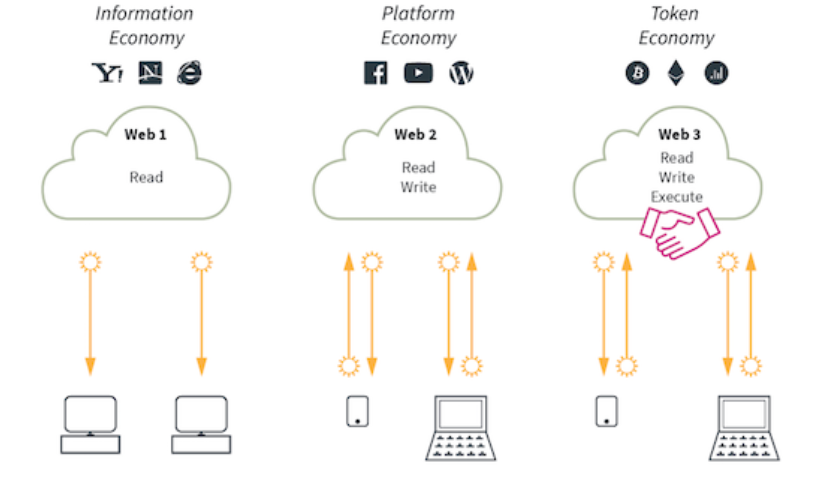
Accessing Web3: Another dark web?
Some of you might think that just a web browser like Chrome/Safari might be sufficient to access the data and write to the blockchain. Others might think that you need to install something special like TOR. Well, actually, it's somewhere in the middle.
Since you need an account to sign and transact on the blockchain, you need a wallet. MetaMask is a very popular Chrome extension crypto wallet. It is your gateway into dApps. Make sure you install it to enter the deep dark world of Web3! There are other wallets too, like Dapper, but MetaMask is the most famous one and we recommend that you use MetaMask for this course.
MetaMask stores all your blockchain network tokens and sometimes spends your tokens to write to the blockchain (reading doesn't require spending any tokens, we will cover that in our gas optimization topic). You cannot interact with the blockchain without a wallet. Your wallet and your wallet address is basically your anonymous identity on the blockchain!
A decision model is a formal system used for perceiving, organizing, and managing the business logic behind a business decision. We will now break down the IBM model to evaluate whether or not one should use a blockchain.
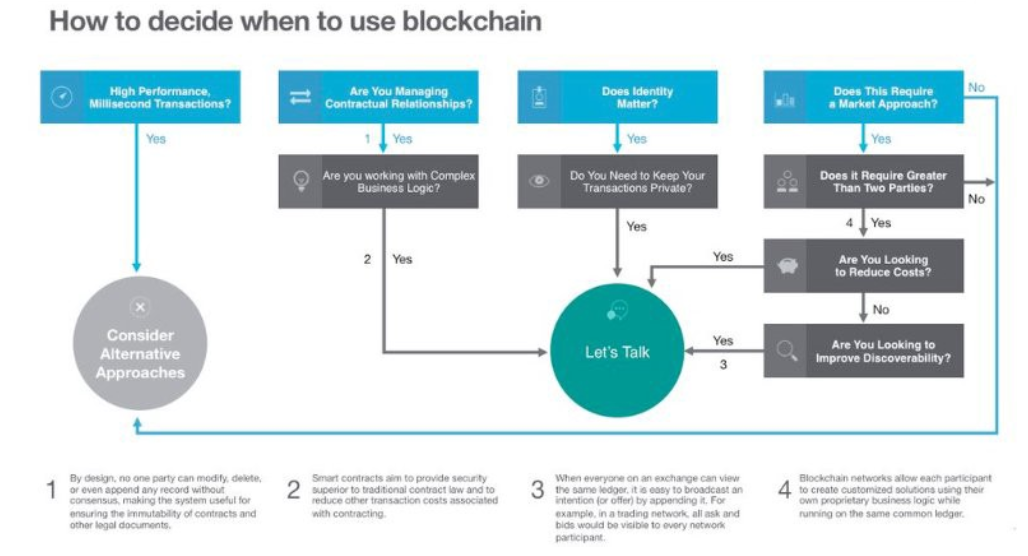
The main idea that the entire model encapsulates, is that a problem to which blockchain would be a possible solution is one that:
- Works with contractual agreements and makes use of complex business logics: The property of immutability of the blockchain comes in handy here to ensure that contracts and other legal documents are tamper proof. Moreover smart contracts provide more security when compared to traditional contract laws and also reduce other transactional costs associated with contracting.
- Requires you to keep your transactions private: The property of traceability of blockchains which allow addresses to not be traced to a physical identity makes the blockchain a perfect solution to such problems.
- Requires a market approach: This problem can be further analysed and broken down into three other key factors to consider before deciding to adopt a blockchain solution
- Whether the potential use case requires greater than two parties: If the answer is YES, then a blockchain solution can come in handy, since decentralized networks give each participant the flexibility to create their own customised solutions using proprietary logic while still keeping it running on a common ledger
- Whether the potential adopter is looking to lower his/her costs: If the answer is YES, then once again a solution revolving around the blockchain would be of use since deploying a blockchain solution can help reduce overhead expenditure. This is done by significantly lowering transaction costs since cryptocurrency payments are handled in a peer to peer network with no centralized authority, which translates into lower merchant processing fees.
- Whether it is important that discoverability is improved: This can be done through a solution making use of the blockchain since every peer in the decentralized network has access to the same ledger, making it easy to broadcast an intention.
In this section we'll do a simple teardown on two important academic papers:
- SoK: Blockchain Technology and Its Potential Use Cases - even though it is currently a draft, the paper is comprehensive in breaking down the comparative benefits of utilising blockchain technology
- SoK: Research Perspectives and Challenges for Bitcoin and Cryptocurrencies.
SoK: Blockchain Technology and Its Potential Use Cases (2019)
Ruoti, S., Kaiser, B., Yerukhimovich, A., Clark, J., & Cunningham, R. (2019). SoK: Blockchain technology and its potential use cases. arXiv preprint arXiv:1909.12454.
Abstract
This paper mainly aims to answer the questions:
- What exactly is Blockchain technology?
- What capabilities does it provide?
- What are good applications for Blockchain technology?
- How does it relate to other distributed technologies [Such as distributed databases]?
It uses grounded theory to achieve this, identifying data and processes within qualitative data sources generated by humans and filled with imprecise terminology and descriptions.
Key Contributions

The technical properties for Blockchain Technology are defined which form the basis for its capabilities. Through participation in the shared governance and operations of the system, the group of individuals can be rest assured that the system is being operated properly. This is guaranteed through the validation rules which culminate in the consensus protocol for the distributed ledger.
The distributed ledger provides a verifiable state for the participants which accurately reflect their transactions.
It also provides resilience to data loss by providing redundancy.
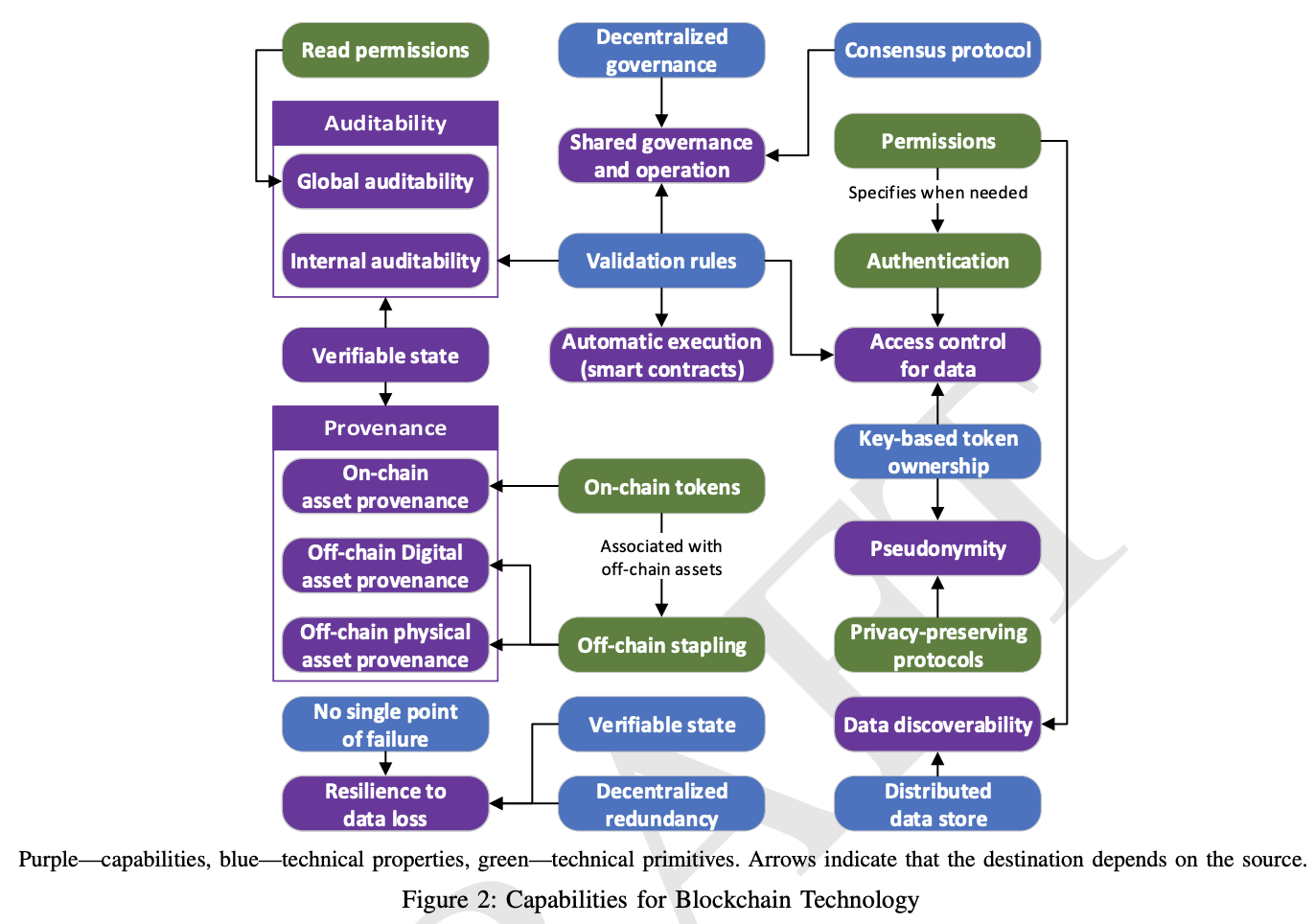
Blockchain Technology is commonly touted to have several different capabilities. This figure helps us make sense of the technical properties and primitives that lead to these capabilities. Blockchain's 3 core capabilities are the shared governance and operations, verifiable state, and resilience to data loss. An additional 11 capabilities are identified that can be achieved on or off-chain. Blockchain use cases develop from the creation of value from these capabilities.
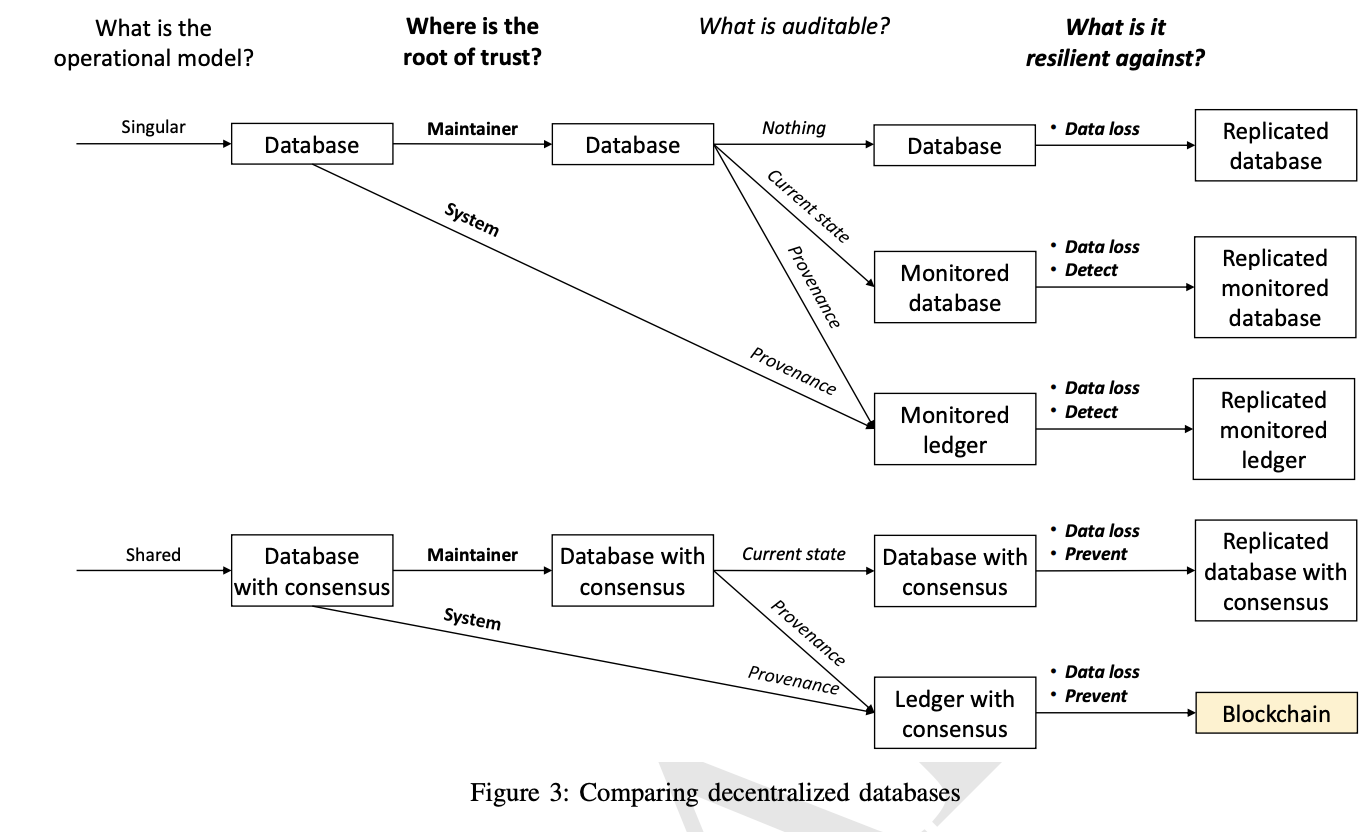
You might then be wondering to yourself how does blockchain compare to other types of decentralized databases. This paper provides a flowchart that helps you to understand this based on 4 key questions.
- The operational model if the database is shared or not;
- The root of trust for the database grounding it in either the maintainer or the system
- Whether the database is auditable in terms of its provenance; and
- What the database is resilient against by looking at how it might prevent or detect data loss.
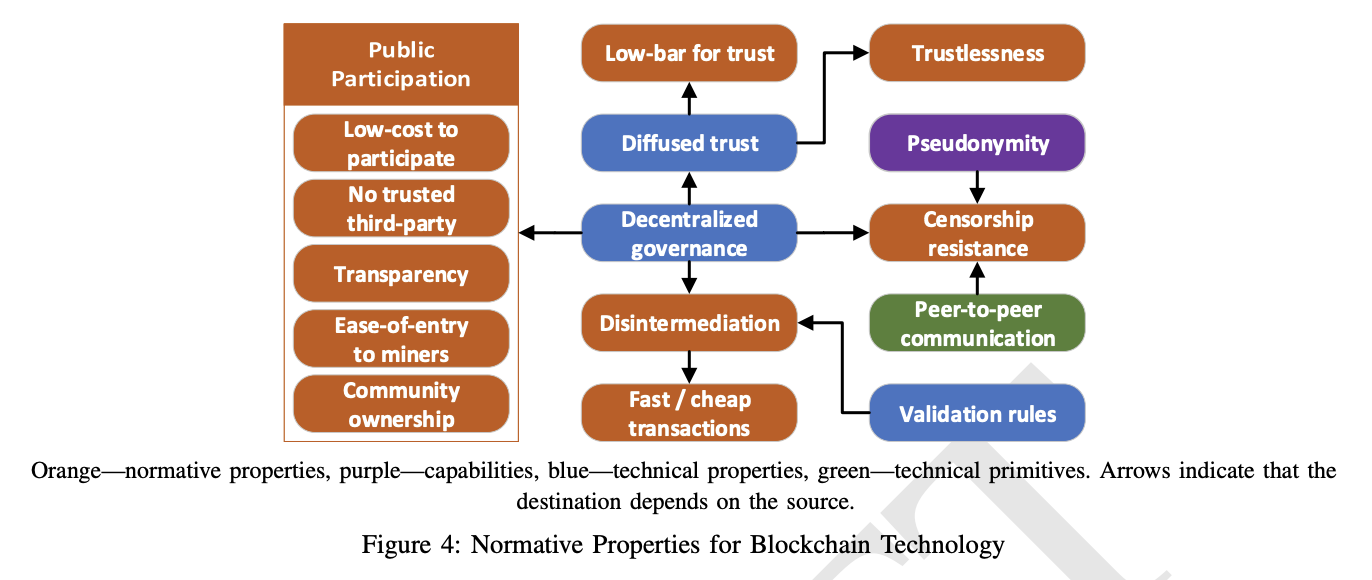
Finally, the paper illustrates some normative properties for Blockchain Technology and illustrates the dependencies to achieve these properties. However, the paper also provides a sobering reminder of the reality of some of these properties.
While public participation is certainly possible with Blockchain technology, as there are many examples of systems built using Blockchain technology that fail to achieve these properties. For example, while Bitcoin initially had a low-cost to participate allowing easy-of-entry for miners and community ownership, that is no longer the case as any meaningful participation requires the purchase of a large amount of specialized hardware and the expenditure of a significant amount of electricity.
To conclude, here's an enumeration of the different use cases for blockchain technology:
- Financial
- Electronic currencies and payments
- Asset trading
- Markets and auctions
- Insurance and futures
- Penalties, remedies, and sanctions
- Data storage and sharing
- Asset tracking
- Identity and key management
- Multi-organization data sharing
- Tamper-resistant record storage
- Others
- Voting
- Gambling and games
- IoT and smart property
These use cases apply a combination of the normative properties of blockchain and its core capabilities. A full explanation is given in the paper and it generally follows the format of use case > challenge at hand > core capability helping to resolve the challenge > limitations.
SoK: Research Perspectives and Challenges for Bitcoin and Cryptocurrencies (2015)
SoK: Research Perspectives and Challenges for Bitcoin and Cryptocurrencies. 2015. 104-121. 10.1109/SP.2015.14.
Abstract
This paper:
- Provides a systematic exposition of Bitcoin and other ‘altcoins'
- Identifies three major components of Bitcoin
- Maps out the design space for proposed modifications
- Survey anonymity issues in Bitcoin
- Provides new insights on disintermediation protocols
One point that we find quite interesting is that this is a pre-ethereum paper which was published in 2015
Now we will break down some of the key phrases that the paper highlights which will form the backbone for further research studies.
- Simple majority compliance may not ensure fairness
- Temporary withholding block withholding can allow miners who are two blocks ahead of the largest publicly known chain to publish the withheld block without any opposition.
- Majority compliance is an equilibrium with perfect information
- On analysing a simplified model where miners have perfect information about all published blocks, it is found that universal compliance is a Nash equilibrium.
- Majority compliance implies convergence, consensus, and liveness
- With a majority of the miners working compaintly it can be shown that a single, longest correct chain can easily emerge. When the original Bitcoin paper modeled a malicious miner looking to reverse a transaction by building an alternate chain faster than the honest chain, it was shown that this miner would eventually lose this race to the network.
- With a majority miner, stability is not guaranteed
- A single non-compliant miner that controls the majority of the network could undermine fairness by:
- Collecting all block rewards
- Arbitrarily censoring transactions
- Introducing arbitrarily long forks in the blockchain
- If miners can collude, stability is not known
- Even with the absence of a miner that controls the majority of the network's mining resources, a group of individual miners can collude and form cartels that control the majority of the mining power.
- Stability is not known as mining rewards decline
- All of these results have used a simplified model in which each block carries a constant, fixed reward fee. The planned transition of miner revenue from block rewards to transaction fees will negate this assumption and require more complex models which take into account the distribution of available transaction fees.
We will now go over the two strategies that give miners, who don't purely derive utility only through mining rewards, an advantage.
- Gold-Finger attack:
- Majority Miner's Goal: To explicitly attack Bitcoin's security and destroy its utility as a currency
- These attacks have already been observed thorough what has been known as altcoin infanticide: Deep forking attacks in new, competing currencies which has been successfully launched by Bitcoin miners
- Feather Forking:
- Majority Miner's Goal: To censor a blacklist of transactions
- This is done by the miner by publicly promising that the blacklisted transaction which has been included in the blockchain will be intentionally ignored by the attacker who would attempt to fork the blockchain.
In this section, for this paper we have just summarized and broken down what we believe are potential research questions that this paper highlights. You are highly encouraged to read the original paper and do a breakdown of your own.
- Sources of information on Bitcoin: Good overview presented in the original whitepaper. Knowledge on current implementation: Bitcoin Improvement Proposals, Wiki articles, Developers Mailing Lists, Logged Bitcoin IRC Discussions.
- Transactions and Scripts
- Transaction Format: an array of inputs and an array of outputs hashed using SHA-256. This hash: Unique transaction ID
- Transaction Scripts: "pay-to-pub-key-hash" refers to a hash of the public key and a signature validation routine. Opcodes is the ad-hoc, non-turing complete stack scripting language that is used.
- Conservation of Value: Transactions are valid only if they satisfy the constraint of the sum of values of transaction inputs being less than or equal to the sum of the values of all the inputs.
- Transaction to Ownership: The concept of ownership of Bitcoins is different from that of traditional assets. An owner: Someone who knows a private key that can make a signature that redeems certain outputs.
- Consensus and Mining:
- Nakamoto Consensus: (Details out the process involved in choosing a new block)
- The first announced valid block containing the solution to a computational puzzle is considered correct, following which other participants (referred to as miners) should start working towards finding a follow up block.
- Malformed blocks and those with invalid transactions are meant to be rejected by the participants.
- At any given point in time the consensus blockchain: longest chain. Finding the solution at the same time leads to temporary forking of the main chain with two chains of equal length.
- Block conformations: Due to the possibility of forking of the main chain, users need to wait for 6 blocks to be found to confirm that their transaction would be permanently included in the blockchain. The choice of 6 has been set arbitrarily.
- Incentivising correct behaviour: Any miner who is able to find the correct solution to the computational hash problem gets a block reward. This gives miners an incentive to work only on valid blocks (What is valid is determined by the majority of other miners)
- Mining details: The puzzle is to find a block (consisting of a list of transactions, hash of the previous block, timestamp, version no. and a nonce) whose SHA-256 hash is less than a target value.
- Can be modeled as a problem to find a hash that starts with d consecutive zeros
- The standard strategy: Simply try random nonces
- Mining rewards: The size of the block reward is determined by a fixed schedule. It was initially set to 50 Bitcoin and is set to half every 4 years. Most miners also profit from transaction fees that users add to their transaction to ensure a higher probability of their transaction being included in the next block.
- Mining pools: In practice, many miners collaborate and form certain mining pools to lower the variance of their rewards by sharing rewards with a group of other miners. This is a threat to Bitcoin's decentralization.
- Peer to peer communication network:
- Impact on consensus: Performance and stability of the network has an impact on the consensus protocol
- Latency between block discovery and its receipt by all other nodes increases the chances of a temporary fork.
- A malicious node who is able to control the majority of the network can favour the broadcast of their own blocks.
- Network topology and discovery: Any node can join the network by connecting to a random sample of other nodes. By default, each node attempts to make 8 outgoing connections and is prepared to receive up to 125 incoming connections. Bitcoin makes use of seed nodes to allow peers to find out about other peers in the network.
- Communication Protocol: New blocks and pending transactions are broadcast to the entire network by flooding.
- INV messages: Sent by nodes to all other peers containing hashes of new blocks and pending transactions
- GETDATA messages: Peers can request the content of these new blocks and transactions
- Replay policy: Bitcoin has a set of stricter validation rules when compared to general transaction validity rules to decide what transactions and blocks can be a relayed to the network. This is done in order to prevent denial of service attacks.
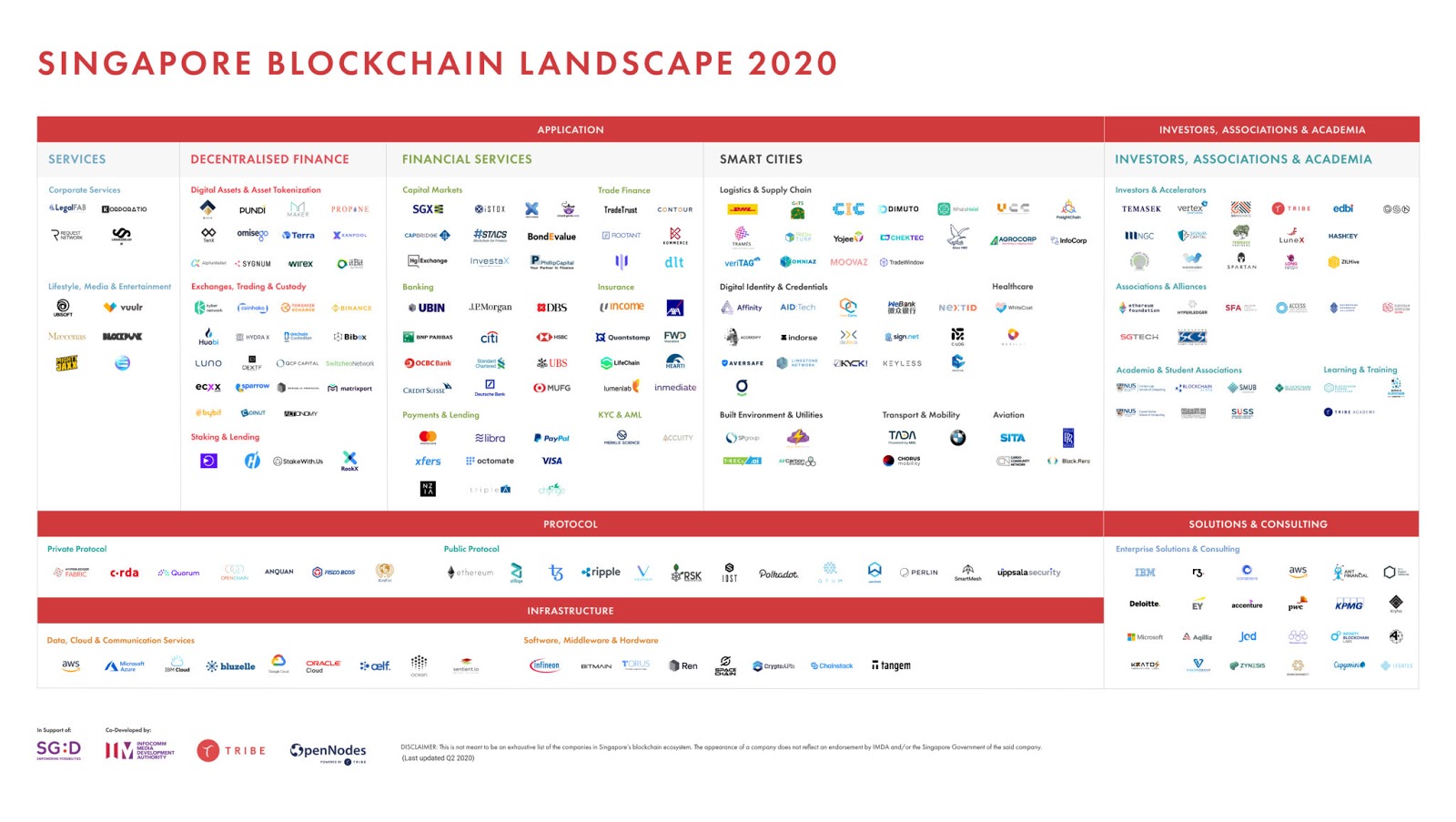
This Blockchain Landscape Map captures all the corporates, startups, government agencies and academic institutions that are working towards improving or adopting blockchain technology.
The map first organises these bodies into those that are working towards:
- Application of Blockchain Technology
- Building the Investor, Association and Academic Landscape
- Blockchain Protocol design
- Infrastructural development
- Providing Solutions and Consulting services for companies looking to adopt Blockchain technology as a part of their operations
The ‘Application' segment is further divided into different subsections based on their blockchain use cases. These subsections are:
- SERVICES: That captures all organisations making use of blockchain technology for providing corporate services and lifestyle, media and entertainment services.
- DECENTRALIZED FINANCE: That captures all organisations using blockchain tech to power their digital assets & asset tokenization initiatives and operations pertaining to exchanges, trading and custody.
- FINANCIAL SERVICES: Which is further broken down into Capital Markets, Trade Finance, Banking, Insurance, Payment and Lending and KYC & AML
- SMART CITIES: That includes Logistics & Supply Chain, Digital Identities and Credentials, Healthcare, Built Environment & Utilities, Transport & Mobility and Aviation.
In this next section, we will introduce you all to the website State of the DAppswhich can be used to check the status of currently launched decentralized applications. Similar sites such as DappRadar and Dapp.com also exist, but in this section we'll mainly turn our attention to the SOTD.
- Objective: First started in 2015 to be a platform to showcase Ethereum based projects. These projects were categorized and the website aimed to allow its users to easily know more about these projects in a single place.
- Website currently supports the mainnets of: Ethereum, EOS, Katlyn, Hive and Blockstack among many others.
SOTD indices:
- Active Users: Refers to the number of active addresses that send transactions to the smart contracts that are implemented using the DApp.
- Transactions: Refers to the total number of transactions generated using the DApp Contract.
- Development Activity: Refers to the activity that has been recorded on the company's GitHub.
- Volume: Amount of Mainnet token being sent following each transaction.
The website also provides its ranking of various DApps using a ranking algorithm based on weighting 14 different factors that include active users, transaction, development activity, profile freshness and strength, click-through-rate, user recommendations and feedback.
Do visit the website and have a look at it yourself!
Using Remix
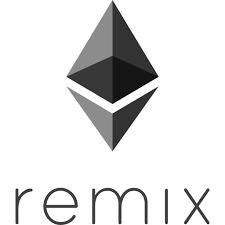
Remix will be your main IDE for today. We use it because it's convenient to compile and test your contracts out quickly.
Ropsten
To gain some experience of what it's like developing on Ethereum, we will use test ether from the Ropsten network. You can do this by using the Ropsten Ethereum Faucet or the Metamask Ropsten Ethereum Faucet.
Before learning how to code/execute a smart contract, you should first understand what is a smart contract, what are some limitations and how it is used in real life scenarios.
What is a smart contract?
A smart contract is a computer protocol intended to digitally facilitate, verify, or enforce the negotiation or performance of a contract. Once the terms of the contract has been fulfilled by the parties, the smart contract will self-execute. Clauses and data of the smart contract will have to be digitally programmed and fed into the blockchain by a trusted third party, known as the oracle. These oracles are often linked to the Internet of Things (IoT) connected devices, which allow the automated monitoring of data.
The beauty of the decentralized nature of blockchain based peer to peer transactions means that these smart contracts don‘t require anything in the way of a middleman. Traditionally individuals or institutions such as banks and solicitors were required to facilitate legally binding contracts. Smart contracts allow individuals to bypass these costly and often slow middlemen and agree on a contract directly. (https://www.devteam.space/blog/10-uses-for-smart-contracts/)

- Benefits of Smart Contracts
- Autonomy – Decentralized nature of the blockchain contracts underlying these smart contracts as well as the nature of the contract themselves means no outside party is required in the process.
- More secure – Blockchain technology creates unalterable ledgers that provide definitive proof of transactions. It also relies on encryption while operating as a secure peer to peer transaction system.
- Faster speeds – Unlike traditional contracts, there is no need for a middleman which reduces the waiting time and increases the speed in which the contract can be drafted, signed and executed.
- Increased accuracy – Humans make mistakes, smart contracts are designed not to.
- Cost savings – The automated process lowers costs significantly.
- Trust – Unalterable ledgers mean transactions are set in stone
- Backup – Data storage devices can fail. Smart contracts duplicate all transactions so that all parties have a record of the transitions. The likelihood that all parties are going to suffer data storage failures is practically nonexistent.
(https://www.devteam.space/blog/10-uses-for-smart-contracts/)
- Limitations to this smart contract
- Immutability - As smart contracts are coded onto blockchain, once set up, the contracts cannot be modified easily. However, it is very common for parties to amendment terms and conditions, especially for long-term contracts whose execution is depending on real-life dynamics. Therefore the rigidity in smart contracts will lead to a wide array of practical problems more so with respect to the ease of modifying the contract terms depending on various situations.
- Contractual Secrecy - the transactions are visible, and there is no security of such. Despite the nodes being anonymous, the maintenance of a public ledger in the distributed environment results in a privacy lapse
- Legal Adjudications and Enforceability - Traditionally, the establishment of a valid contract covers various constructs such as offer by one party or parties, acceptance by the other party or parties, a promise, consideration, and legal capacity mutuality and in some contracts, a written instrument. Some elements are not applicable to smart contracts and therefore regulations need to come up with a new set of enforcement to prove a smart contract to be valid
- how you can use it (life use cases that are somewhat familiar)

(https://www.thedigitalenterprise.com/op-ed/smart-contracts-real-life-use-cases/)
- Finance Industry
Smart contracts are gaining the most traction in the finance industry and many financial institutions are adopting blockchain and smart contracts to simplify and digitize their process. The Swiss Bank, UBS has recently adopted the use of blockchain and smart contracts to create a self-paying instrument which will be risk-free and is an available payment stream for the unbanked people. This kind of micro contracts can enable microfinancing which can help in the payment of everyday goods.
- Healthcare
The healthcare industry faces several issues pertaining to data conservation and patient privacy. With the use of Smart contracts, middlemen can be eliminated. Applicature, a blockchain development application was developed through smart contracts to foster data integrity, transparency and secure record of patients' health data.
- Music Industry
An example from the Music Industry is Inmusik, a music streaming platform that decentralizes revenues and has a proper allocation of revenues to the respective artists, solving one of the common issues in the music streaming industry. A common issue faced in the music industry is that revenues fail to reach the content creators' hand due to centralization, lack of transparency over ownership of the content, royalties payment and many more. With the help of smart contracts, Inmusik enables the validation of the ownership of a song through a transparent tagging system. As a result, the party who creates the track gets the right portion of fees allocated from the royalties.
These are some of the many few real examples that industries and companies have adopted smart contracts to simplify and digitize their operations, introducing transparency and accuracy which reduces cost. Really, smart contracts will soon be used in your everyday life.
Let's dive right into real smart contracts on the blockchain. Smart contracts are compiled before being migrated onto the blockchain. Thus you need to decompile them.
- Choose a smart contract from State of the dapps
- Decompile it with eveem by Tomas Kolinko
- Understand the decompiled code, formatting it properly might help!
- Discuss with your partner what this smart contract does
- Share with the class
We analysed a decompiled auction contract from OpenSea.
Simply by looking at the decompiled code, we noticed:
- Each
auctionwas a struct - How
requireworks - Some basic checks on deciding price upper and lower limits
- Assigning values to variables
- Event logging
def createAuction(address _tokenAddress, uint256 _tokenId, uint256 _startingPrice, uint256 _endingPrice, uint256 _duration, address _seller): # not payable
require not uint8(stor0.field_160)
require _startingPrice < 0xffffffffffffffffffffffffffffffff
require _endingPrice < 0xffffffffffffffffffffffffffffffff
require _duration <= 18446744073709551615
require ext_code.size(_tokenAddress)
call _tokenAddress.ownerOf(uint256 tokenId) with:
gas gas_remaining - 710 wei
args _tokenId
require ext_call.success
require ext_call.return_data[12 len 20] == caller
require ext_code.size(_tokenAddress)
call _tokenAddress.transferFrom(address from, address to, uint256 value) with:
gas gas_remaining - 710 wei
args caller, addr(this.address), _tokenId
require ext_call.success
require uint64(_duration) >= 60
auction[addr(_tokenAddress)][_tokenId].field_0 = _tokenAddress
auction[addr(_tokenAddress)][_tokenId].field_256 = _seller
auction[addr(_tokenAddress)][_tokenId].field_512 = uint128(_startingPrice)
auction[addr(_tokenAddress)][_tokenId].field_640 = uint128(_endingPrice)
auction[addr(_tokenAddress)][_tokenId].field_768 = uint64(_duration)
auction[addr(_tokenAddress)][_tokenId].field_832 = uint64(block.timestamp)
log AuctionCreated(
address contract=addr(_tokenAddress),
uint256 tokenId=_tokenId,
uint256 startingPrice=_startingPrice << 128,
uint256 endingPrice=_endingPrice << 128,
uint256 duration=uint64(_duration))
This information presented in this section is obtained from the paper: Issuing and Verifying Digital Certificates with Blockchain, which can be accessed here.
The problem:
- Counterfeit certificates being issued
- Lengthy process involving the verification of a large number of certificates
The solution that is being proposed: UniCert (Based on UniCoin, a digital currency built on blockchain technology)
Existing solution: Blockcert
- What it does: Joins the Bitcoin network and makes use of its transaction structure to maintain certificate records.
- Why use the Bitcoin network: Transparency and Availability
- Potential Drawbacks:
- By tying itself to the Bitcoin network, it also ties itself to the Bitcoin market at fluctuating rates resulting in the issuing of certificates to become unpredictable.
- With the scale of the Bitcoin network increasing, it becomes more expensive for new nodes to join the network due to expensive fees.
How does UniCerts work?:
Step 1: Collection of necessary information for the certification process
Step 2: Hashing of the certificate and storing it in the metadata of the transaction. The hashing is carried out using the Merkle Tree hashing algorithm
Step 3: Pushing of transactions into UniCerts thereby letting it join the validation process
Step 4: Receiving the certificate's hash as an identity number once the transaction validations is complete
Step 5: Retrieving the original certificate wherever necessary which requires the identity number
How does this address the existing issues revolving around the current system:
- It prevents counterfeit certificates from being issued since all the certificates that are validated through the system and a unique identity is provided to determine the validity of these referenced certificates.
- The lengthy validation is shortened since the entire process happens by pushing transactions into UniCerts rather than going through a centralised authority overseeing the entire process of issuing these certificates.
At this point, you are highly encouraged to go back and do your own teardown of the paper and understand the UniCerts and UniCoin architecture by yourself! This section covers the rough overview of the project and does not go into the architecture.
Other exciting blockchain focused solutions to this problem that you are encouraged to check out are: 0xcert and OpenCerts.
Dev tools are important as it reduces development time.
To interact with the blockchain, it is common to start with geth, which will install the whole ethereum blockchain on your computer. However this might take hours, which is not practical if you are trying out blockchain technology.
Therefore to allow you to work with the Ethereum blockchain without running a full node there are several methods such as;
- Infura, a hosted Ethereum node cluster that lets your users run your application without requiring them to set up their own Ethereum node or wallet
- Web3js, make requests to an individual Ethereum node with JSON RPC in order to read and write data to the network
- HDWalletProvider, for account management process required when signing transactions on the blockchain such as metamask
This list is not exhaustive as new and better ways are still being created.
To work even faster especially for proofs-of-concepts or hackathons, we can use Ganache. Ganache is a popular personal ethereum client which you can use to run tests, execute commands, and inspect state while controlling how the chain operates.
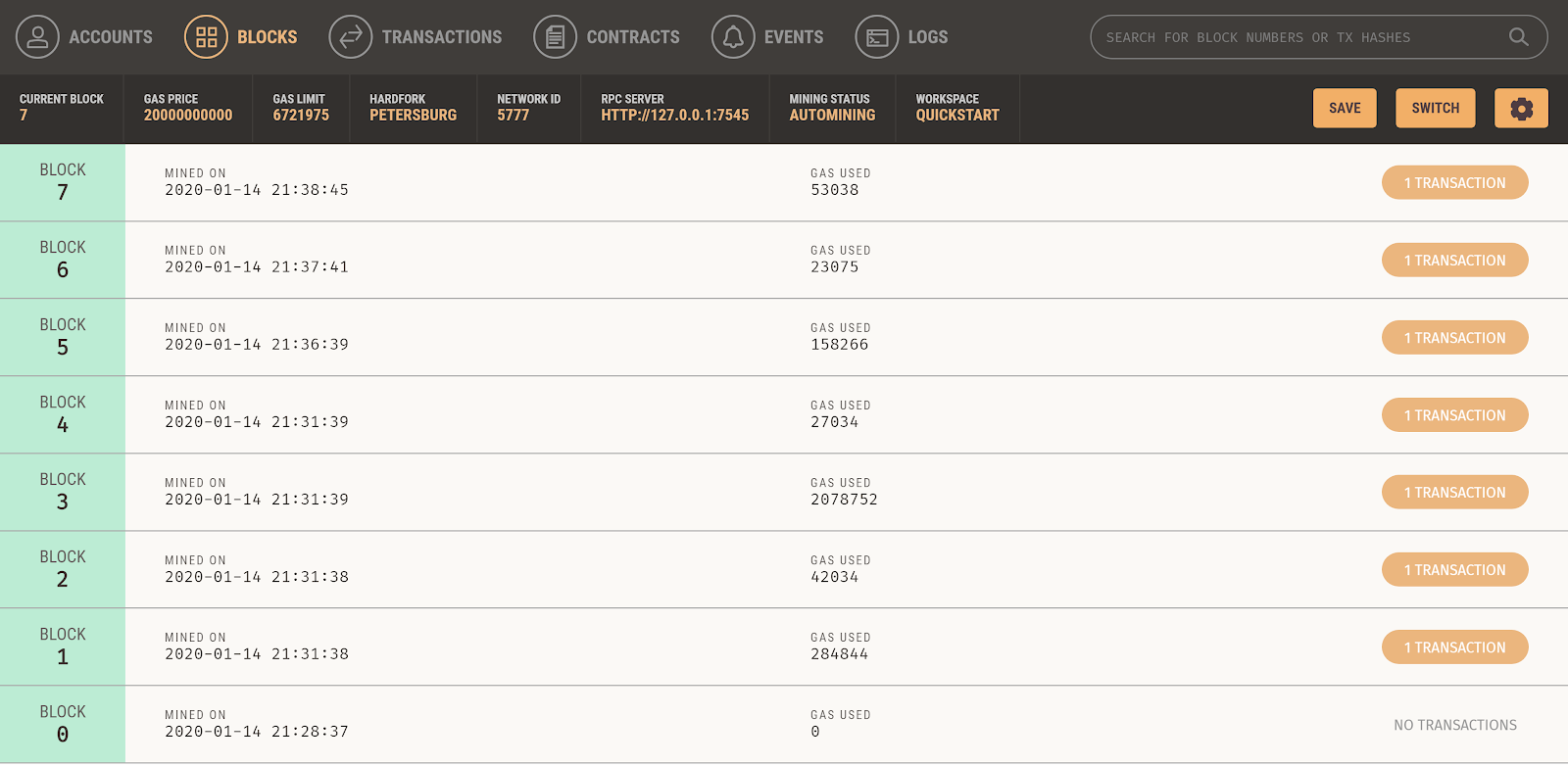
Most tutorials have their networks deployed on a mix of Ganache and Ethereum testnet(s) connected via infura.
To speed up the development and code testing, we have Truffle which is a development environment, testing framework and asset pipeline for Ethereum. truffle init creates the following file structure, which provides the base for our project.
File structure:
- contracts/: Contains theSolidity source files for our smart contracts. There is an important contract in here called
Migrations.sol, which we'll talk about later. - migrations/: Truffle uses a migration system to handle smart contract deployments. A migration is an additional special smart contract that keeps track of changes.
- test/: Contains both JavaScript and Solidity tests for our smart contracts
- truffle-config.js: Truffle configuration file
Below is a short walkthrough of truffle commands for creating and setting up your project.
1. truffle init : generates sample files for solidity contracts
2. edit solidity smart contracts
3. truffle compile : compiles .sol into .json format
4. ganache-cli : starts ganache-cli, make sure ganache-cli is already installed (this step is only for deployment on ganache, else skip this step)
5. create a 2deploycontracts.js file with code to export module
6. update truffle.js configuration for module.exports networks
7. truffle migrate (--network ropsten) (--reset): deployment of contracts on ganache/ ropsten / redeploy contract even though one with the same solidity code has been previously deployed.
- truffle console : console to run web3apis to interact with web3 JS apis (link below) (e.g. web3.eth.getTransactionReceipt or calling functions from the smart contracts by using
Bounties.deployed().then(function(instance) {...})
If you haven't decided on a code editor, use Visual Studio Code! There's dark mode, syntax highlighting is pretty and there is a decent Solidity Syntax Plugin by Juan Blanco for Visual Studio Code you can download which is especially useful since many tutorials online have outdated solidity code and this handy code editor can remind you of the new solidity code syntax.
From the pace at which the development tools in blockchains are developed and new versions of solidity language are pushed out, it is common that the tutorial you have been following is outdated and you'll are sitting in broken code. When in doubt, google! You'll be likely directed to issues on github pages or stackoverflow and you can follow their instructions.
But what should i do if i don't know where the problem is? It goes without saying that a good understanding of would be very beneficial to the debugging process. I highly recommend getting started with the articles on the ethereum developers page where just the introductory section is enough to get a good understanding of how the compilation and deployment process works. The truffle links they provide are also helpful if you are looking to write your projects in truffle. Here's the page: https://ethereum.org/developers/
If you are looking to develop an app which requires reading the state of some part of the blockchain, knowledge of web3js and how metamask works would be helpful.
Sometimes there is more than one problem. When I was editing the code for the project on voting, I noticed that the Event always on loading if metamask is enabled in browser. So i went to the place in the code where I check if there is a current provider for web3 and perform a few console logs to check the state of my accounts and voila! I found my problem: Web3.getaccounts returned an empty array. With help from stack overflow i picked the possible underlying problems (solvable with actions):
- Problem 1: metamask would not be injected on local files, so in order to access my metamask account, use the Chrome extension Web Server for Chrome to convert local file (e.g //newfile) to https://127.00.02
- Problem 2: To unlock my account, I have to write code to enable metamask (which prompts the user to allow site access to the account) as part of metamask's privacy feature (new!)
As you can see, some knowledge of how these things work is essential to pinpoint the location of the error (in this case I checked web3.currentProvider). And from there onwards stack overflow and github issues help to identify the deprecated features and other developer's workaround to the issue with the correct keywords.
Other interesting issues:
- Callback for web3js required (fixed with web3js v1.0 as it uses promises now!)
- Restoration of accounts on metamask and what I learnt about how accounts are generated on metamask
Today we will learn about Ethereum development through working with several smart contracts and dapps. Each segment is separated into:
- Deploy the smart contract and explore every function
- Logic behind the working of the smart contract
- Syntax of the smart contract with explanations
- Discuss if the smart contract fulfills its intended objectives well, how it can do better in terms of gas use and security, and how one might induce unintended behaviour in the smart contract.
- Develop based on our earlier discussion, new functions or fixes for the smart contract
- Digest what you've just learned by searching for other real-life examples
Before we dive into writing our smart contract, let us take a quick glance at the syntax of solidity itself. We assume that you have some programming experience before and understand the syntax of any popular pre-existing language as we will be drawing similarities.
Keyword | Meaning |
| A smart contract object. Somewhat similar to a class as it contains data and logic inside functions but that's where the similarities end. (For more advanced programmers, contracts can be visualised as a singleton object hosted on the public blockchain and hence constructor is called once per deployment and not once per object creation) |
| Import statement similar to other languages. |
| Create a function inside a contract that can be called |
| Unsigned Integer type with 256 bits |
| Unsigned integer with number of bits. |
| String type |
| Boolean type |
| A key, value pair. Similar to Dictionaries or HashMaps |
| Similar to if in most languages |
| Similar to else in most languages |
| Similar to for in most languages |
Welcome to your first ever smart contract. Since it is your first time, we thought you would need some hand-holding and decided to walk you through all the steps involved in deploying the smart contract to the Ropsten Test Network.
Deploy
Mortal Greeter is the "Hello World" equivalent to familiarise users with smart contracts via remix GUI.
We have provided the Mortal/Greeter Smart Contract Code below for you to test and deploy the contract.
- Open the Remix IDE
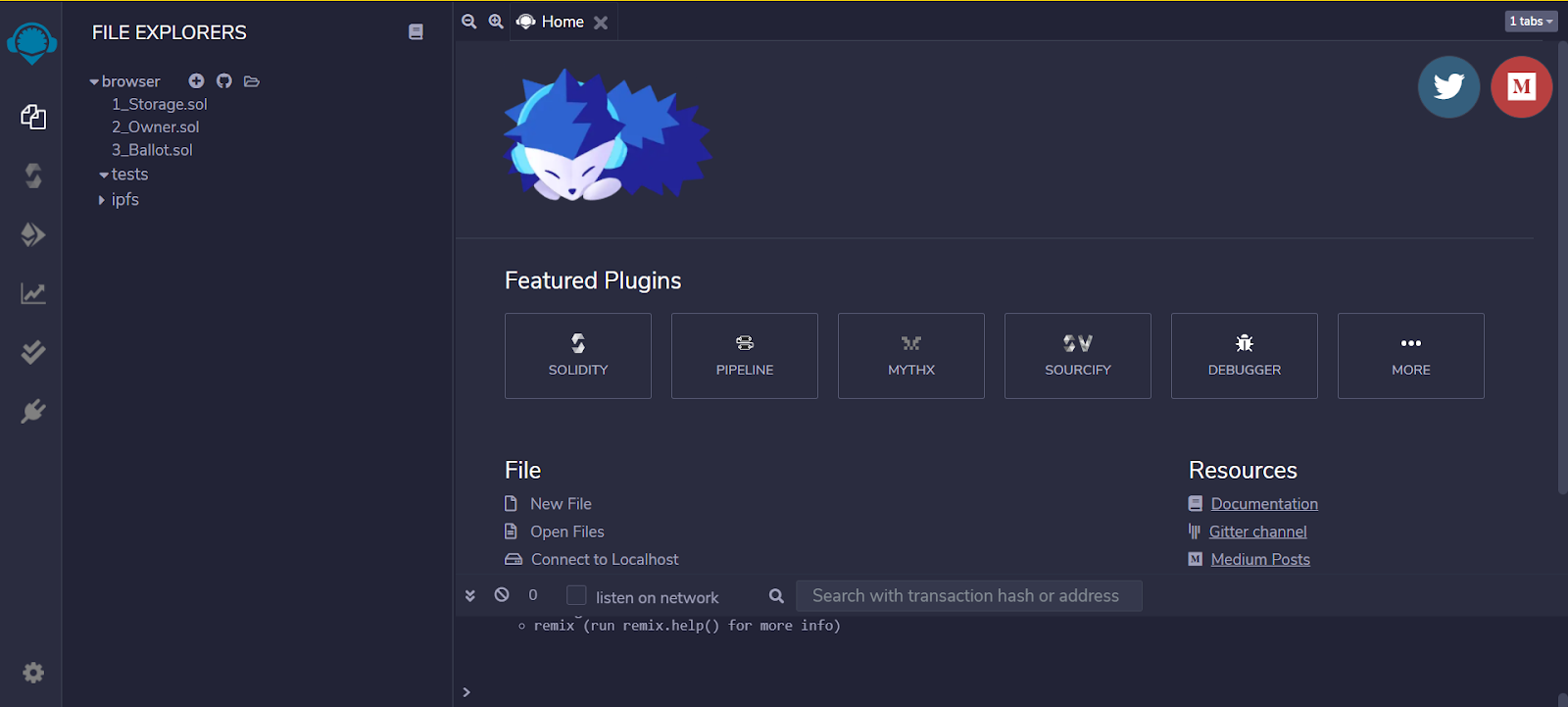
You should see something similar to this! This is your IDE for basic smart contracts! Play around and get(h) used to it.
- You can customise your solidity compiler by choosing the solidity plugin. You can change it to 0.6.6 as that's the version we will be using throughout this course.
- Once you're familiar with the IDE, create a new file named Greeter.sol and paste the smart contract code into it (available below).
- Save the file once and you should see it compile automatically. Make sure you see the green tick next to the solidity compiler which signifies a successful compilation.
- Head to the deploy and run transactions (the one below solidity compiler on the left nav bar). Change the environment to Injected Web3 (this is to make sure that you deploy to the actual blockchain and not a temporary local one. You will most likely get a MetaMask prompt and make sure that you connect your account on the ropsten network!

- Leave the gas limit and value as is (tweak if you know what you're doing) and go down to the deploy section.
- Choose a greeting string for the constructor. Remember, once you choose a word, you cannot change it as it is permanently stored on the blockchain! Hit deploy. Confirm your transaction with MetaMask.
- Once the transaction has been mined (you will get a notification from MetaMask). You can see the address of the deployed contract! Hurray! You've deployed your first smart contract on the Ropsten Ethereum Network! It is ingrained forever in the blockchain!
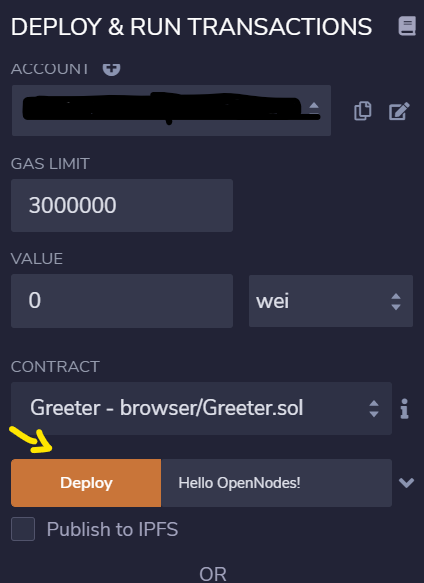
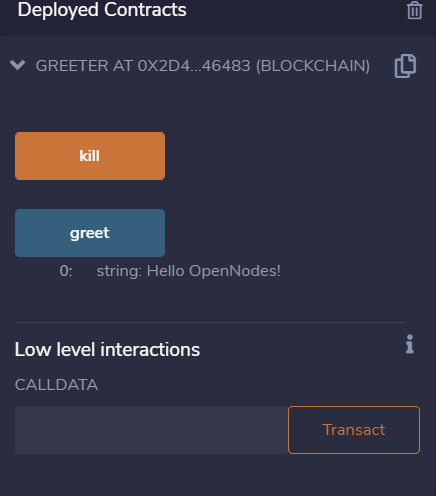
- You can call the methods using the Remix GUI by clicking on the method. You can see that it says "Hello OpenNodes!" just like we wanted it to. You can even copy your contract address and check it out on Ropsten Etherscan!
Logic
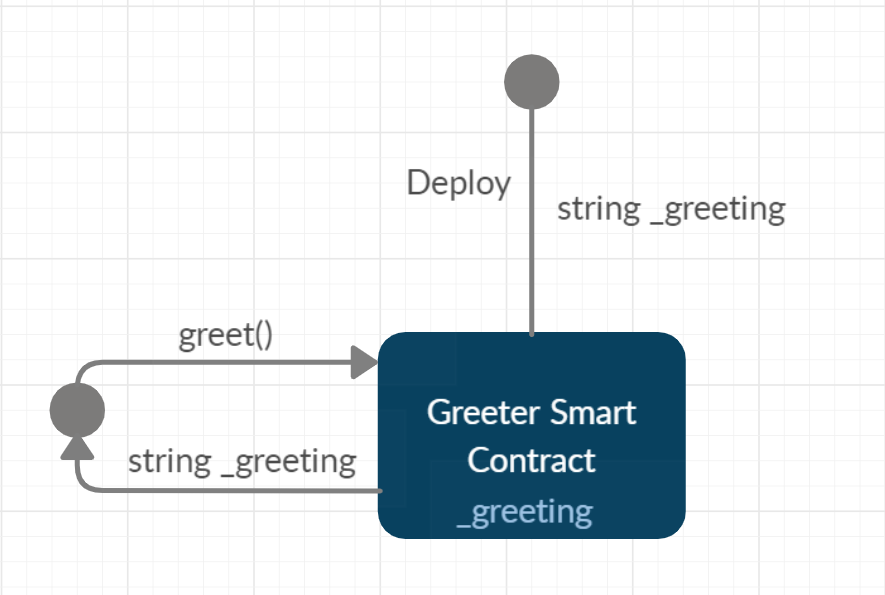
Code
pragma solidity ^0.6.6;
/* the above line specifies the version of the solidity compiler that */
/* this program is compatible with. */
contract Mortal {
/* Define variable owner of the type address */
/* address is a type that stores wallet and contract addresses */
address owner;
/* This constructor is executed only once at deployment and sets the owner of the contract */
constructor() { owner = msg.sender; }
/* Function to recover the funds on the contract */
/* notice how function access modifiers are specified after the name */
function kill() public {
if (msg.sender == owner)
selfdestruct(msg.sender);
}
}
/* Another contract Greeter which inherits from Mortal */
/* Inheritance in Solidity is similar to OOP where */
/* all the methods and data members (that are not private) are */
/* accessible in the subclass */
contract Greeter is Mortal {
/* Define variable greeting of the type string */
string greeting;
/* This runs when the contract is deployed */
/* public functions are functions that can be called by people while private functions are functions that can only be called by contracts */
constructor(string memory _greeting) public {
greeting = _greeting;
}
/* Main function that can be called by people */
/* notice how data is returned */
function greet() public view returns (string memory) {
return greeting;
}
}
Further Points to note on the Syntax
- Notice that the string parameter in the constructor is tagged with memory.
- There are two types of variables in smart contracts:
storageandmemory. - Storage - variables permanently stored on the blockchain (similar to pass by reference)
- Memory - temporary variables erased between external function calls (similar to pass by value)
- Storage variables can only interact within the contract ecosystem as the memory address of the variables have no meaning outside the Ethereum Virtual Machine.
- Question: Can public functions (which can be called from outside the blockchain) have storage parameters?
- You might be familiar with public and private modifiers but what about the view modifier?
- View functions only read the data from the blockchain but doesn't write to the blockchain.
- View functions hence don't cost gas. Gas is needed to run code on the blockchain that changes the storage of the contract.
msg.sender:Each function call can access the address of the caller of the function through this variable.
Discuss
- What do you think of the deployment process?
- What happens if you want to change the greeting?
Digest
Before you get all excited, we will be making a MetaEther/MyEther. Our own currency backed by the blockchain/smart contracts. There are a few standards for tokens like ERC20 and ERC721. ERC20 tokens hold the same value and are interchangeable (a good fit for a currency).
Deploy
Before we get into deploying our own currency, let us take a look at the standards. OpenZeppelin has a list of smart contracts that are tried and tested and they've made it open-source for all of us to use. Yay! They have contracts like SafeMath, ERC20 and Ownable that are widely used. Most production-ready smart contracts usually inherit from one of the OpenZeppelin contracts. You can take a look at all their contracts here. We will be using their ERC20 Contract to make our own ETH.
Ownable is used when contracts have an owner who has admin privileges that normal users don't. SafeMath is used to prevent overflows during math operations.
Logic
This section is a little light on coding. The ERC20 Standard Interface and its implementation is given below (a shorter version of the OpenZeppelin Contract). We will just inherit it, in our contract.
Code
Below is the syntax for your contract.
pragma solidity ^0.6.0;
import "./openzeppelin/ERC20.sol";
contract MyETH is ERC20 {
constructor(uint256 initialSupply) public ERC20("MyETH", "METH") {
_mint(msg.sender, initialSupply);
}
}
Code for the ERC20 Implementation given for your reference. Give it a read. Make sure all your imports are in the right structure.
// SPDX-License-Identifier: MIT
pragma solidity ^0.6.0;
import "./Context.sol";
import "./IERC20.sol";
import "./SafeMath.sol";
contract ERC20 is Context, IERC20 {
using SafeMath for uint256;
mapping (address => uint256) private _balances;
mapping (address => mapping (address => uint256)) private _allowances;
uint256 private _totalSupply;
string private _name;
string private _symbol;
uint8 private _decimals;
constructor (string memory name, string memory symbol) public {
_name = name;
_symbol = symbol;
_decimals = 18;
}
function name() public view returns (string memory) {
return _name;
}
function symbol() public view returns (string memory) {
return _symbol;
}
function decimals() public view returns (uint8) {
return _decimals;
}
function totalSupply() public view override returns (uint256) {
return _totalSupply;
}
function balanceOf(address account) public view override returns (uint256) {
return _balances[account];
}
function transfer(address recipient, uint256 amount) public virtual override returns (bool) {
_transfer(_msgSender(), recipient, amount);
return true;
}
function allowance(address owner, address spender) public view virtual override returns (uint256) {
return _allowances[owner][spender];
}
function approve(address spender, uint256 amount) public virtual override returns (bool) {
_approve(_msgSender(), spender, amount);
return true;
}
function transferFrom(address sender, address recipient, uint256 amount) public virtual override returns (bool) {
_transfer(sender, recipient, amount);
_approve(sender, _msgSender(), _allowances[sender][_msgSender()].sub(amount, "ERC20: transfer amount exceeds allowance"));
return true;
}
function increaseAllowance(address spender, uint256 addedValue) public virtual returns (bool) {
_approve(_msgSender(), spender, _allowances[_msgSender()][spender].add(addedValue));
return true;
}
function decreaseAllowance(address spender, uint256 subtractedValue) public virtual returns (bool) {
_approve(_msgSender(), spender, _allowances[_msgSender()][spender].sub(subtractedValue, "ERC20: decreased allowance below zero"));
return true;
}
function _transfer(address sender, address recipient, uint256 amount) internal virtual {
require(sender != address(0), "ERC20: transfer from the zero address");
require(recipient != address(0), "ERC20: transfer to the zero address");
_beforeTokenTransfer(sender, recipient, amount);
_balances[sender] = _balances[sender].sub(amount, "ERC20: transfer amount exceeds balance");
_balances[recipient] = _balances[recipient].add(amount);
emit Transfer(sender, recipient, amount);
}
function _mint(address account, uint256 amount) internal virtual {
require(account != address(0), "ERC20: mint to the zero address");
_beforeTokenTransfer(address(0), account, amount);
_totalSupply = _totalSupply.add(amount);
_balances[account] = _balances[account].add(amount);
emit Transfer(address(0), account, amount);
}
function _burn(address account, uint256 amount) internal virtual {
require(account != address(0), "ERC20: burn from the zero address");
_beforeTokenTransfer(account, address(0), amount);
_balances[account] = _balances[account].sub(amount, "ERC20: burn amount exceeds balance");
_totalSupply = _totalSupply.sub(amount);
emit Transfer(account, address(0), amount);
}
function _approve(address owner, address spender, uint256 amount) internal virtual {
require(owner != address(0), "ERC20: approve from the zero address");
require(spender != address(0), "ERC20: approve to the zero address");
_allowances[owner][spender] = amount;
emit Approval(owner, spender, amount);
}
function _setupDecimals(uint8 decimals_) internal {
_decimals = decimals_;
}
function _beforeTokenTransfer(address from, address to, uint256 amount) internal virtual { }
}
Discuss
Make sure you go through the Ownable Contract as most contracts in deployment inherit from that!
Let us take a look at a more advanced smart contract which has a real-life use case.
Deploy
You are able to send Ether to your agreement, set new terms, and withdraw Ether if an agreement has been violated.
- Replace
**with your address and your roommate's address - The
Idacts like a password and you need to put the same Id as your address' position in the array it is stored - Interact with your roommate's contract!
Logic
We are going to model the idea of roommates creating agreements with each other and claiming disputes when the other violates said agreement. It can be visualised as so. This is similar to a normal contract and we are going to make it "smart".

Code
pragma solidity ^0.6.6;
pragma experimental ABIEncoderV2;
contract RoomieAgreement {
// Events are to pass information when something happens on the blockchain to your front-end
// Your front-end can listen/watch for these events
event NewAgreement (uint agreementId, string agreementTerms);
event NewDispute (uint disputeId, string dispute, uint _claim, address claimant);
// Variables must be declared
uint agreementId = 0;
uint minDepositVal = 1;
// Solidity only support integers
uint minDeposit = minDepositVal / 1000;
uint totalDeposit = 0;
uint disputeId = 0;
//Structs let you create data types with multiple properties
struct agreement {
uint agreementId;
string agreementTerms;
}
// Declare an array called agreements of type agreement (a struct) that is publicly viewable
// Note that the public modifier only enables public read and not public write
agreement[] public agreements;
// hardcoded addresses of your roomies
address[] public roomies = [**, **];
// Mappings are like dictionaries, it's 1 to 1
mapping (address => uint) public roomieDeposits;
// This function checks that you submit the minimum deposit and includes it
// The payable modifier lets you send money to the smart contract through this function
// Notice the use of msg.value
// We are not passing the value of money through the parameter
// But taking it from the transaction which calls the function
function addDeposit() public payable {
//require checks a condition. if it fails, it kills the current transaction and reverts
require(msg.value > minDeposit);
// mapping
roomieDeposits[msg.sender] = msg.value;
totalDeposit = totalDeposit+msg.value;
}
// This is actually an experimental function but let's you check the agreements
function viewAgreements() public view returns (agreement[] memory) {
return agreements;
}
//This lets you view the current total deposits
function viewDeposits () public view returns (uint) {
return totalDeposit;
}
// This function checks that you picked your right Id and adds your new agreement
function createAgreement(string memory _agreementTerms, uint _roomieId) public {
require(roomies[_roomieId-1] == msg.sender);
agreementId++;
// array.push is used to add element at the end of dynamic array
agreements.push(agreement(agreementId,_agreementTerms));
// Event is fired off when this function is complete
emit NewAgreement(agreementId,_agreementTerms);
}
// This function lets you execute a claim and will send it to the claimant
function createDispute(uint _dispute, uint _claim, uint _roomieId) public {
// notice the use of payable again
address payable claimant = msg.sender;
require(roomies[_roomieId-1] == msg.sender);
require(_dispute <= agreementId);
disputeId++;
string memory dispute = agreements[_dispute-1].agreementTerms;
//Event is fired off when this function is complete
totalDeposit = totalDeposit-_claim;
claimant.transfer(_claim);
emit NewDispute(disputeId, dispute, _claim, claimant);
}
}
Further Points to note on the Syntax
- Events are for you to communicate that something happened on the blockchain to your app frontend
- Events can also be used as a gas-cheap way to burn data into the blockchain rather than storing it in the storage of your contract
- You can fire an event using the
emitkeyword. - Require: This statement allows you to check a condition and immediately end the transaction/function call if the condition is not satisfied. It is similar to assertion.
- Floating point numbers are not supported in Solidity yet. One way to bypass this is to use smaller units. Example, you can send 1.5 Ether using Smart contracts. But behind the scenes, Ether is converted to wei, which is the smallest unit of token. (1018 wei = 1 ether). You cannot divide a wei.
- Payable: This is a very important keyword when it comes to writing smart contracts. All it takes for your function to accept Ether is to add this keyword as a modifier.
- When a user calls your function (either directly or through web3), they can specify how much ether (in wei) that they want to send. This value can be accessed through
msg.value. - Once some money is sent to the smart contract, it stays in the smart contracts' balance (can be accessed through
address(this).balance) and you can also transfer funds from the contract to an address using transfer. Make sure the address is payable too!
Discuss
- Privacy - you have put your contract address on the blockchain, how about private voting?
- Fake claims - your roomie can essentially just claim all the money anytime
- Lack of adjudication - how do you know who was right or wrong in a dispute?
- Gas guzzling - are there more efficient ways to write this contract?
- Game theory - how do you incentivise someone to not abuse the claiming function?
- What is wrong with the Dispute function? How can we do it better?
Develop
Advanced: Implement a solution to any one of these problems we have discussed.
Simple passwords
Having a simple password on the contract. Note that the password should at least be hashed.
uint[] private passwords = [12345, 123456]; //should be hashed
function createAgreement(string _agreementTerms, uint _roomieId, uint _password) public {
require(roomies[_roomieId-1] == msg.sender);
require(_password == passwords[_roomieId-1]);
agreementId++;
agreements.push(agreement(agreementId,_agreementTerms));
// Event is fired off when this function is complete
emit NewAgreement(agreementId,_agreementTerms);
}
Adding a username password pair
Before allowing the transaction, check if the password and username is correct. Again, this should be hashed. Also, the return function should be an emit instead.
bool has_Login = false;
function enterPassword(string _username, string _password) public returns (string memory){
if (keccak256(abi.encodePacked((_username))) == keccak256(abi.encodePacked(("hello"))) && keccak256(abi.encodePacked((_password))) == keccak256(abi.encodePacked(("yes")))){
has_Login = true;
return "Welcome!"; // emit welcomeMessage(bool _has_Login);
}
else {
return "Login Failed!"; // emit welcomeMessage(bool _has_Login);
}
}
function addDeposit() public payable {
//require checks a condition. if it fails, it kills the current transaction and reverts
require(msg.value > minDeposit);
require(has_Login == true);
roomieDeposits[msg.sender] = msg.value;
totalDeposit = totalDeposit+msg.value;
}
Note: You compare strings in solidity by comparing their hashes as shown above. If you want to check if two strings are equal, use keccak256(abi.encodePacked((_name))) == keccak256(abi.encodePacked(("NAME")).
Intermediate: Create a function that adds another party as an adjudicator
bool disputeApproval = false;
function approveDisputeClaim() public {
require(msg.sender==roomies[2]);
disputeApproval = true;
}
function createDisputeAdjudication(uint _dispute, uint _claim, uint _roomieId) {
require(disputeApproval == true);
address claimant = msg.sender;
require(roomies[_roomieId-1] == msg.sender);
require(_dispute <= agreementId);
disputeId++;
string dispute = agreements[_dispute-1].agreementTerms;
//Event is fired off when this function is complete
totalDeposit = totalDeposit-_claim;
claimant.transfer(_claim);
disputeApproval = false;
emit NewDispute(disputeId, dispute, _claim, claimant);
}
Beginner: Do some research on escrow contracts and share with the workshop
Digest
Deploy
This is a message board that can hold up to 10 messages and allows you to post messages. Same process for deployment as the previous contracts.
Logic
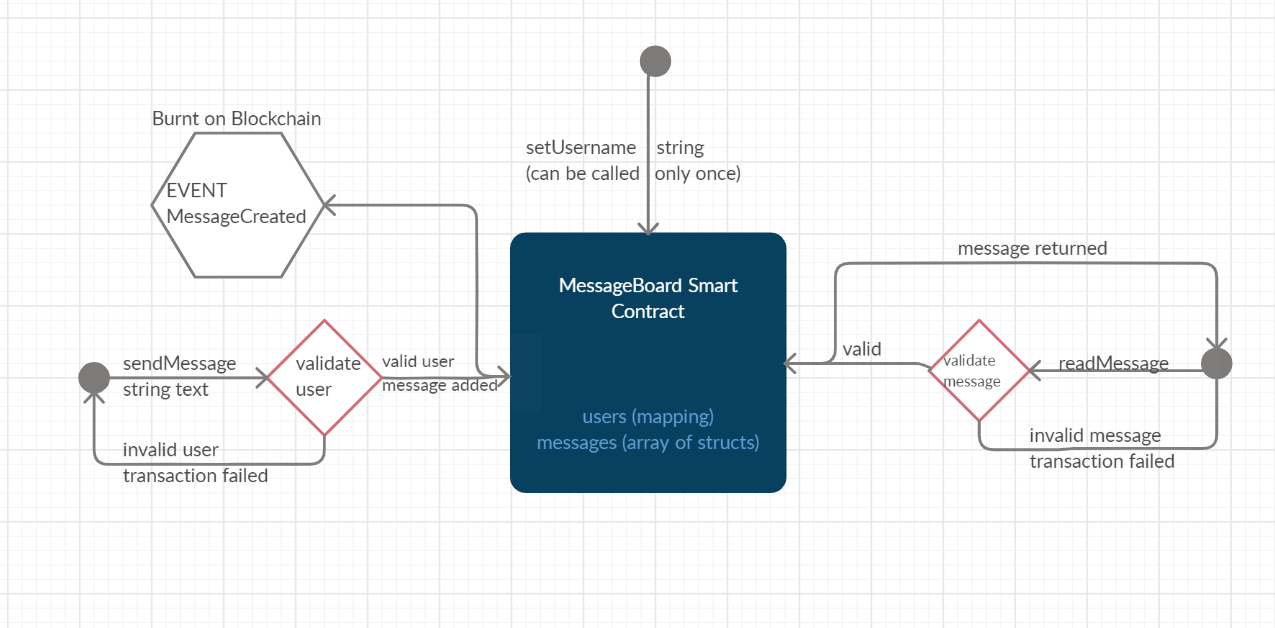
Code
pragma solidity ^0.6.6;
//Contract is just like classes
contract MessageBoard {
//Defining User structure. address is a variable type from solidity
struct User {
address _address;
string name;
bool isValue;
}
//Defining Message structure. You can see it has User type member
struct Message {
string text;
User _user;
}
Message[10] messageBoardLogs;
//8 bit unsigned integer (so no negative values).
uint8 public messageCount = 0;
//mapping is a key value store. We are specified type of key and value
mapping (address => User) users;
//Declaring an event
event MessageCreated (string text, address _address, string name, bool isValue );
//We are using view keyword, to specify that it is not modified the state of contract. It will consume less resources.
function userExists(address _userAddress) view public returns (bool) {
return users[_userAddress].isValue;
}
// public function, which is returning boolean
function setUsername(string memory _name) public returns (bool) {
//require() is throwing error, if the input is not true
require(userExists(msg.sender) == false, "userAddress has been previously registered");
//msg.sender is the address, from where the signUp was called.
users[msg.sender] = User(msg.sender, _name, true);
return true;
}
//it is creating an event Message with text and user.
function sendMessage(string memory _text) public returns (bool) {
//require() is throwing error, if the input is not true
require(userExists(msg.sender) == true,"msg.sender is not added into users");
messageCount++;
emit MessageCreated(_text, users[msg.sender]._address,users[msg.sender].name,true);
messageBoardLogs[messageCount] = Message(_text, users[msg.sender]);
return true;
}
function readMessage(uint _messageIndex) view public returns (string memory){
require(_messageIndex<=messageCount,"message index out of range");
return messageBoardLogs[_messageIndex].text;
}
}
Discuss
- Can there be a better structure for how messageboards keep messages? The current deployed messageboard can only keep track of the first 10 messages to be written to the board.
- How should we rewrite the code such that the last 10 messages are kept instead?
- Useful feature: currently messages can only be accessed by message index, how about a feature to access the latest message?
- Would a dynamic array which increases in size as more people write to the messageboard be better than our fixed-length message board?
- What are some ways to disincentivize spam on the messageboard?
Develop
Advanced: Implement a solution to any one of these problems we have discussed.
Implement a check to prevent consecutive posting and payment
Ensure that any post will need to be paid for
address prev;
uint minVal = 1;
uint minDeposit = minVal / 10000;
function sendMessage (string text) public payable returns (bool) {
//require() is throwing error, if the input is not true
require(userExists(msg.sender) == true,"msg.sender is not added into users");
require(msg.sender != prev, "You're already the previous sender! Wait a while.");
require(msg.value >= minDeposit);
messageCount++;
latest++;
latest = latest % maxLog;
emit MessageCreated(text, users[msg.sender]._address,users[msg.sender].name,true);
messageBoardLogs[latest] = Message(text, users[msg.sender]);
prev = msg.sender;
return true;
}
Make message posters perform some form of proof-of-work
Store proofs that have already been done to prevent repeats. Message posters will have to hash their text and a nonce to form their own proof. Check that the proof has 4 leading 0s.
mapping (bytes32 => bool) proofs;
//it is creating an event Message with text and user.
// To control for spam, must hash your message with a nonce to obtain a proof with
// required amount of leading zeros.
function sendMessage (string text, uint256 nonce, bytes32 proof) public returns (bool) {
//require() is throwing error, if the input is not true
require(proofs[proof] == false);
require(keccak256(abi.encodePacked(text, nonce)) == proof);
require(userExists(msg.sender) == true,"msg.sender is not added into users");
require(proof[0] == 0);
require(proof[1] == 0);
require(proof[2] == 0);
require(proof[3] == 0);
proofs[proof] = true;
messageCount++;
emit MessageCreated(text, users[msg.sender]._address,users[msg.sender].name,true);
messageBoardLogs[messageCount] = Message(text, users[msg.sender]);
return true;
}
Intermediate: devise a solution for the 10 message limit
//messageBoardLogs can store up to 20 messages
Message[21] messageBoardLogs;
//state change when messageBoardLogs is full
bool messageBoardLogsFull = false;
//Declaring an event
event MessageCreated (string text, address _address, string name, bool isValue );
//empty constructor will be generated at compile-time if code is not provided.
//constructor() public {}
//mapping is a key value store. We are specified type of key and value
mapping (address => User) users;
// public function, which is returning boolean
function setUsername(string memory name) public returns (bool) {
//require() is throwing error, if the input is not true
require(userExists(msg.sender) == false, "userAddress has been previously registered");
//msg.sender is the address, from where the signUp was called.
users[msg.sender] = User(msg.sender, name, true);
return true;
}
//8 bit unsigned integer (so no negative values).
uint8 public messageCount = 0;
//it is creating an event Message with text and user.
function sendMessage (string memory text) public returns (bool) {
//require() is throwing error, if the input is not true
require(userExists(msg.sender) == true,"msg.sender is not added into users");
//replaces message when threshold message number exceeded
if(messageCount<=20){
messageCount++;
}else{
messageBoardLogsFull = true;
messageCount = 1;
}
emit MessageCreated(text, users[msg.sender]._address,users[msg.sender].name,true);
messageBoardLogs[messageCount] = Message(text, users[msg.sender]);
return true;
}
function userExists(address userAddress) public view returns (bool) {
return users[userAddress].isValue;
}
function readMessage(uint messageIndex) public view returns (string memory text){
if(messageBoardLogsFull == false){
require(messageIndex<=messageCount,"message index out of range");
}else{
require(messageIndex<=21,"message index out of range");
}
return messageBoardLogs[messageIndex].text;
}
function readLatestMessage() public view returns(string memory text){
require(messageCount>0,"there are no messages in messageBoardLogs");
return messageBoardLogs[messageCount].text;
}
}
Is it possible to use dynamically sized arrays?
Beginner: what are some ways that people have used blockchain to share messages?
Digest
Deploy
This contract simulates a simple voting process. There are 2 candidates you can vote for.
Logic
Each voter (by voter, we mean a single wallet address account on ethereum) can cast a single vote to a single candidate. A user can only vote once (this is ensured using a require).
Code
pragma solidity ^0.6.6;
contract Election {
// Model a Candidate
struct Candidate {
uint id;
string name;
uint voteCount;
// uint _candidateId;
}
// Store accounts that have voted
mapping(address => bool) public voters;
// Store Candidates
// Fetch Candidate
mapping(uint => Candidate) public candidates;
// Store Candidates Count
uint public candidatesCount;
// voted event
event votedEvent (
uint indexed _candidateId
);
constructor () public {
addCandidate("Candidate 1");
addCandidate("Candidate 2");
}
function addCandidate (string memory _name) private {
candidatesCount ++;
candidates[candidatesCount] = Candidate(candidatesCount, _name, 0);
}
function vote (uint _candidateId) public {
// require that they haven't voted before
require(!voters[msg.sender], "if voter is not msg.sender");
// update candidate vote Count
candidates[_candidateId].voteCount ++;
// trigger voted event
emit votedEvent(_candidateId);
}
}
Further points on the syntax
- You may have noticed that all function parameter variable names begin with an _ (underscore). This is the convention that most people follow when writing smart contracts.
- They also declare the member variables, modifiers (you will learn about declaring modifiers in the next segment), events and functions in that respective order.
Discuss
- How might we bribe the voters? (and get away with it)
- Can we implement a time limit to voting?
- Can we make the vote private?
- Is the voting process secure?
- Semaphores: privacy on the blockchain https://medium.com/coinmonks/to-mixers-and-beyond-presenting-semaphore-a-privacy-gadget-built-on-ethereum-4c8b00857c9b
Develop
Advanced: Implement a solution to any one of these problems we have discussed.
Intermediate: Implement a way you can check that the candidate is valid and the voter votes only once.
function vote (uint _candidateId) public {
// require that they haven't voted before
require(!voters[msg.sender], "if voter is not msg.sender");
// require a valid candidate
require(_candidateId > 0 && _candidateId <= candidatesCount,"if candidate not valid");
// record that voter has voted
voters[msg.sender] = true;
// update candidate vote Count
candidates[_candidateId].voteCount ++;
// trigger voted event
emit votedEvent(_candidateId);
}
Beginner: what other aspects of the democratic process could be decentralised?
Digest
Deploy
Rinse and repeat. Make sure you change the ** to the address of admins so that only the admins can change the answer.
Logic
The aforementioned admins can change the answer (which is stored in a bytes32 variable, bytes32 is an encoded character list). Once a user is registered, he can update his status (his reply to the question). If his status matches the set answer, the user gets points.
Code
pragma solidity ^0.6.6;
contract Users {
// bytes32 can be visualised as an encoded string
bytes32 answer;
// data structure that stores a user
struct User {
string name;
string status;
address walletAddress;
uint createdAt;
uint updatedAt;
uint points;
}
// it maps the user's wallet address with the user ID
mapping (address => uint) public usersIds;
// Array of User that holds the list of users and their details
User[] public users;
// event fired when an user is registered
event newUserRegistered(uint id);
// event fired when the user updates his status or name
event userUpdateEvent(uint id);
// Modifier: check if the caller of the smart contract is registered
// modifiers will be explained in detail in the further points section
modifier checkSenderIsRegistered {
require(isRegistered());
// use _ to return to the calling function
_;
}
/**
* Constructor function
*/
constructor() public {
// Some dummy data
addUser(address(0x333333333333), "Leo Brown", "Available");
addUser(address(0x111111111111), "John Doe", "Very happy");
addUser(address(0x222222222222), "Mary Smith", "Not in the mood today");
}
function postAnswer(string memory _answer) public returns(bytes32) {
require(msg.sender==** || msg.sender==** || msg.sender==**);
answer = keccak256(abi.encode(_answer));
}
/**
* Function to register a new user.
*
* @param _userName The displaying name
* @param _status The status of the user
*/
function registerUser(string memory _userName, string memory _status) public
returns(uint)
{
return addUser(msg.sender, _userName, _status);
}
/**
* Add a new user. This function must be private because an user
* cannot insert another user on behalf of someone else.
*
* @param _wAddr Address wallet of the user
* @param _userName Displaying name of the user
* @param _status Status of the user
*/
function addUser(address _wAddr, string memory _userName, string memory _status) private
returns(uint)
{
// checking if the user is already registered
uint userId = usersIds[_wAddr];
require (userId == 0);
// associating the user wallet address with the new ID
usersIds[_wAddr] = users.length;
users.push(User({
name: _userName,
status: _status,
walletAddress: _wAddr,
createdAt: now,
updatedAt: now,
points: 0
}));
// emitting the event that a new user has been registered
emit newUserRegistered(users.length - 1);
return users.length - 1;
}
/**
* Update the user profile of the caller of this method.
* Note: the user can modify only his own profile.
*
* @param _newUserName The new user's displaying name
* @param _newStatus The new user's status
*/
function updateUser(string memory _newUserName, string memory _newStatus) checkSenderIsRegistered public
returns(uint)
{
// An user can modify only his own profile.
uint userId = usersIds[msg.sender];
User storage user = users[userId];
if (keccak256(abi.encode(_newStatus)) == answer){
user.points += 10;
}
user.name = _newUserName;
user.status = _newStatus;
user.updatedAt = now;
emit userUpdateEvent(userId);
return userId;
}
/**
* Get the user's profile information.
*
* @param _id The ID of the user stored on the blockchain.
*/
function getUserById(uint _id) public view
returns(
uint,
string memory,
string memory,
address,
uint,
uint,
uint
) {
// checking if the ID is valid
require( (_id > 0) || (_id <= users.length) );
User memory i = users[_id];
return (
_id,
i.name,
i.status,
i.walletAddress,
i.createdAt,
i.updatedAt,
i.points
);
}
/**
* Return the profile information of the caller.
*/
function getOwnProfile() checkSenderIsRegistered public view
returns(
uint,
string memory,
string memory,
address,
uint,
uint,
uint
) {
uint id = usersIds[msg.sender];
return getUserById(id);
}
/**
* Check if the user that is calling the smart contract is registered.
*/
function isRegistered() public view returns (bool)
{
return (usersIds[msg.sender] > 0);
}
/**
* Return the number of total registered users.
*/
function totalUsers() public view returns (uint)
{
// NOTE: the total registered user is length-1 because the user with
// index 0 is empty check the contructor: addUser(address(0x0), "", "");
return users.length - 1;
}
}
Further points on the syntax
- You can make your own modifiers in Solidity! Like how there is public/private. You can also restrict the access further using custom modifiers (you can also use modifiers to execute common code)
- Modifiers are half-functions that are used to modify other functions, usually to check some requirements prior to execution. They are executed first, before the function itself, during a function call.
- We use _; to give the control back to the function. Think of it as a compulsory return statement when writing modifiers.
- In the above example, if a function has the checkSenderIsRegistered, only registered users can successfully call the function
- Modifiers can have parameters also, as you will see in the final challenge!
Discuss
- Why is this question-answer app flawed?(ie. people from scoring multiple points with same question, answer checks for exact string and a different way of expressing the same answer would not award you the point.)
- What are some added functions that would be useful? (ie. a constraint that allows one answer after every question is asked would prevent people from scoring multiple points with same question)
Digest
Develop
How can you make something similar? Our challenge is built along the ideas of this smart contract.
Process of creating a dapp (beginners)
- Design contract functions with retrieval of information in mind and think about any potential vulnerabilities arising from the code
- Test out your contract functions on remix ide to make sure that the contract works as expected
- Initialise sample project using
truffle initto create your own sample project and copy and paste the solidity code - Create front end html and link it up with web3js to interact with the contract
- Configure network in
truffle.jsortruffle-config.jsfor deployment of contracts
Congratulations! You have reached the end of this guide.
The University ecosystem in Singapore, our blockchain research collective.
The blockchain industry in Singapore, OpenNodes.
Are you up for the challenge?